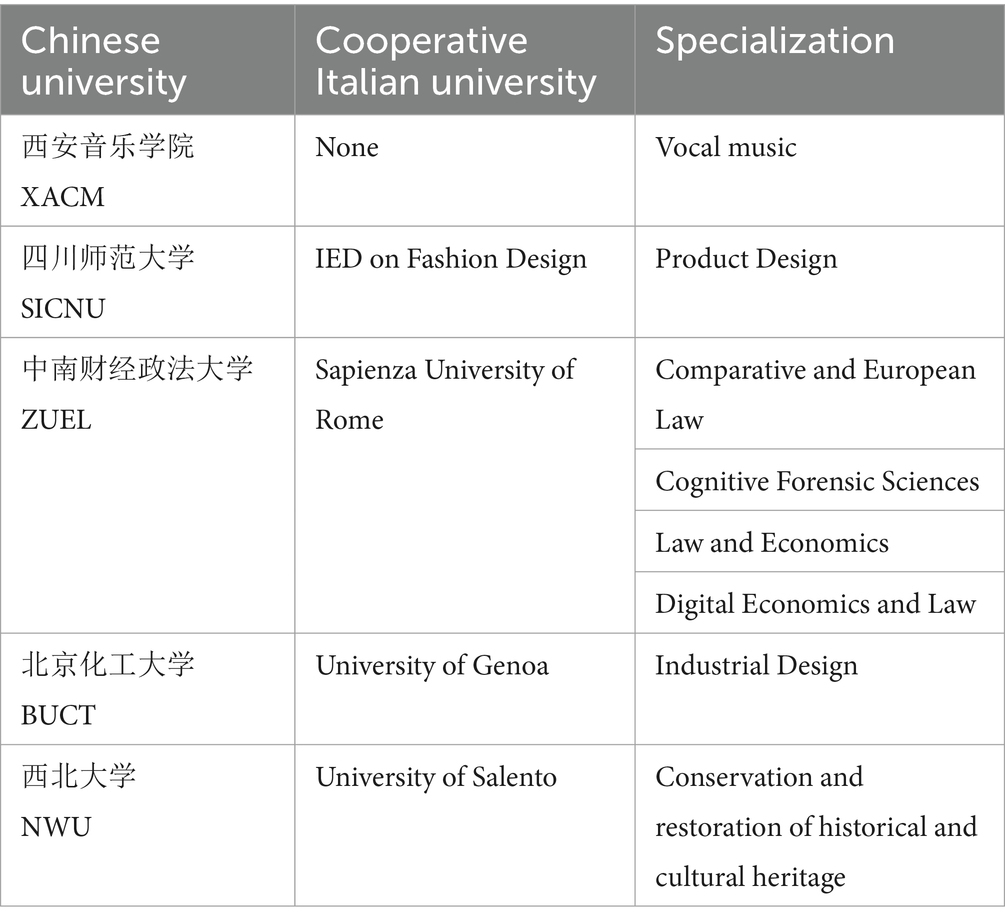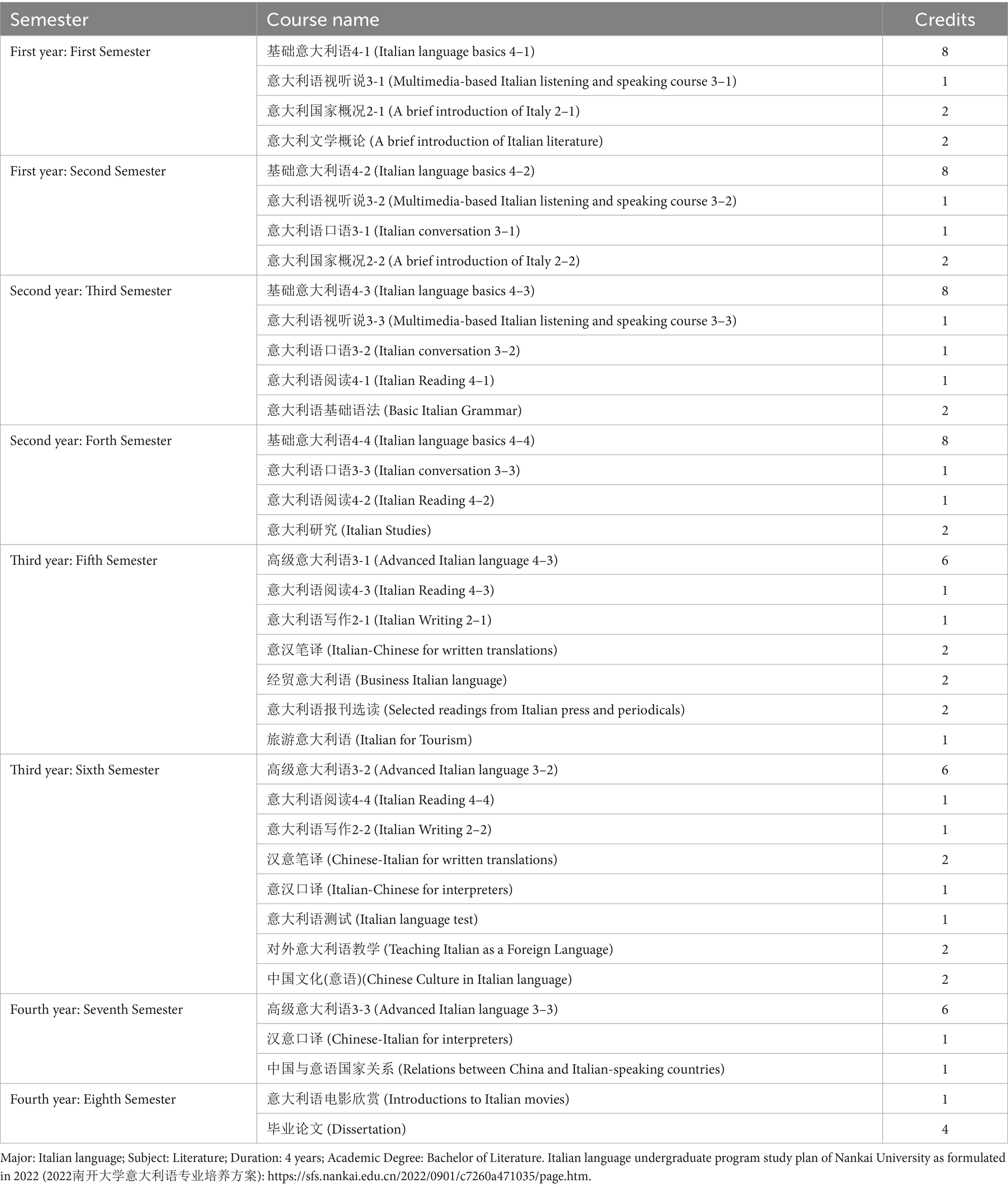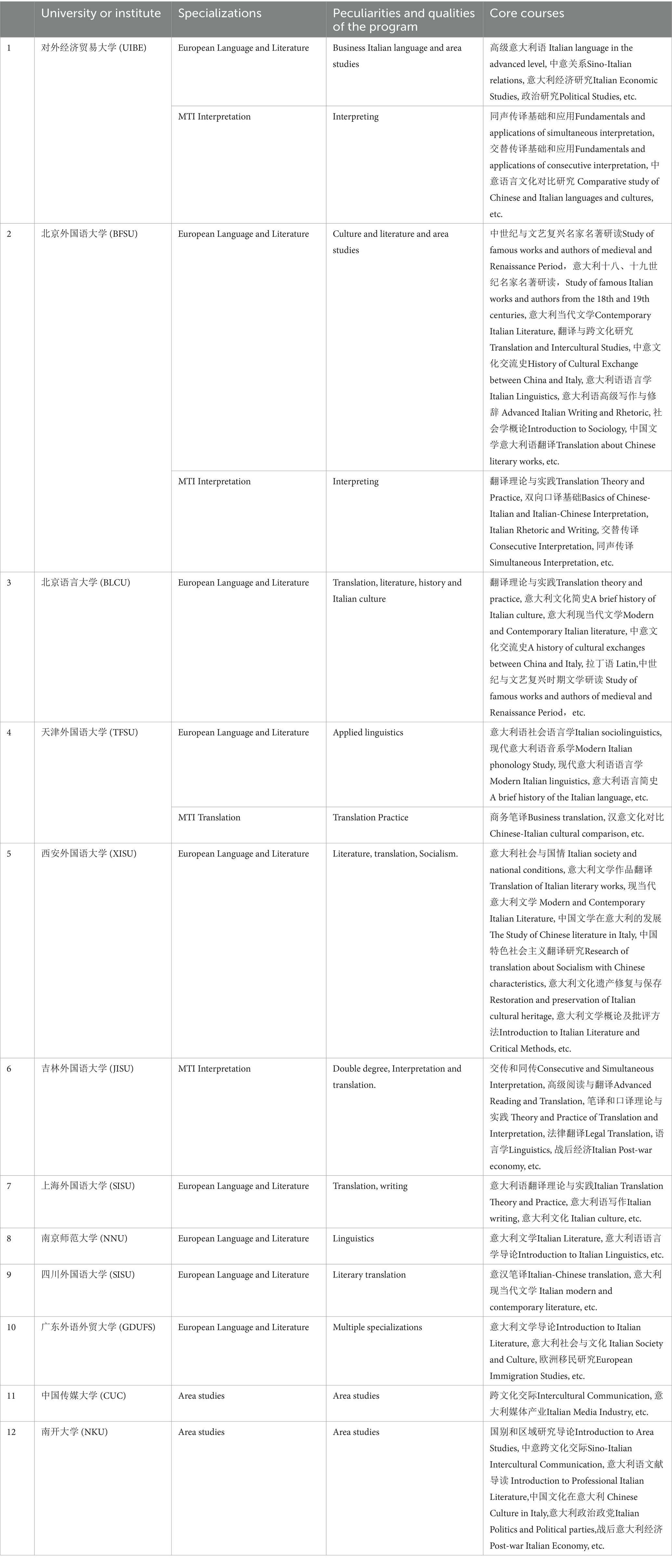- Department of French and Other European Languages, School of Foreign Studies, Zhongnan University of Economics and Law, Wuhan, China
In the growing context of economic globalization, trade and exchanges between countries around the world are more and more frequent. This brings about an increasing demands of experts in foreign languages. It has been already 71 years since the University of International Business and Economics (UIBE) in Beijing launched the first Italian language program in 1954. Currently, there are 24 universities and institutes across the country (including Hong Kong and Macao) offer the academic degree related to Italian language and culture. Furthermore, many other universities and higher education institutions provide Italian language courses. This paper briefly reviews the history of teaching Italian language and culture in China. The aim of this study is to provide a comprehensive overview regarding the current state of teaching Italian language and culture within Chinese higher education system. This paper also covers the relevant teachers’ educational background, their academic titles and the use of teaching material, etc. In particular, this study sheds some light on the state of teaching the aforementioned subjects in Chinese institutions (universities, institutes, vocational and technical institutes) that provide Italian language and culture as elective, compulsory or minor courses, and the teaching situation to graduate students, which was not thoroughly explored in previous studies. Furthermore, this paper shows the various types of course program, the number of students enrolled and some peculiar difficulties of providing these kinds of courses to Chinese learners.
1 Introduction
Italian teaching in Higher Education in China has developed from a zero level to a significant one, and has improved along with the constant development of Sino-Italian bilateral relations. A recent noteworthy event occurred in November 2024 (from 7 November to 12 November), when the Italian President of the Republic, Sergio Mattarella, visited China. This was his second visit after 7 years.
On the occasion of State Visit, the “China-Italy University Presidents’ Dialogue”(“Dialogo dei Rettori tra le Università cinesi e italiane”) took place on 9 November at Peking University, organized by the Ministry of Education of the PRC in collaboration with the Ministry of University and Research of the Italian Republic (MUR—Ministro dell’Università e della Ricerca della Repubblica Italiana) and the CRUI—Conference of Rectors of Italian Universities (Conferenza dei Rettori delle Università italiane). In this conference, six agreements have been signed between Chinese and Italian institutions for the creation of research centers, bilateral high-level training initiatives, and the construction of an international campus. The minister of the Ministry of Education of the PRC, Jinpeng Huai怀进鹏, subsequently expressed the hope that Chinese and Italian universities will deepen their scientific collaboration, especially in basic research and in emerging and interdisciplinary sectors.1
That afternoon Italian President Sergio Mattarella led a delegation to visit Peking University and delivered a Lectio Magistralis at Peking University. Mattarella pointed out that universities are important places for cultivating critical thinking and play an indispensable role in the contemporary education system. Mattarella was pleased that the “China-Italy University Presidents’ Dialogue” has been held and said that this dialog was not only an opportunity for academic discussion, but also an occasion for the exchange of ideas between the people of the two countries, and an occasion for joint growth. He hoped that through this dialog, the cooperation between China and Italy in higher education could reach a new level.2
Therefore, it is important to analyze the challenges and opportunities of Italian language and culture teaching in higher education in China. In the last part, the future prospects are examined.
2 Literature review
The Italian language, as a non-generally foreign language, and its cultural teaching started relatively late in China. Due to the limited number of Chinese students learning Italian, there is relatively little literature about the state of teaching in China.
Zhi (2011) conducted a thorough study on the history, the situation, and the development of Italian Language Teaching in China. She divided the development process of Italian teaching in China into four stages: (1) the preparatory stage (1949–1955), (2) the initial stage (1955–1966), (3) the recovery stage after the Cultural Revolution (1970–1978), and (4) the rapid development stage after the Chinese economic reform (1978–2011, the year of publication).3 She analyzed the current situation of Italian language teaching, pointed out the achievements and shortcomings, and gave suggestions for the development of Italian language teaching in China, such as strengthening the training for young teachers and improving teachers’ scientific research capabilities, etc. This was the first attempt to investigate the situation of Italian language teaching in China.
Liu (2017) published a paper titled “The Mutual Promotion and Influence of Foreign Language Teaching and International Relationships—Taking Italian Language Teaching in China and Sino-Italian Relations as an example.” In this thesis, the author divided the development of Sino-Italian relations into six stages: (1) before the fall of the Qing Dynasty (before 1912), (2) from the fall of the Qing Dynasty to the foundation of the PRC (from 1913 to 1949), (3) from the foundation of the PRC to the formal establishment of diplomatic relations between Italy and China (from 1950 to 1970), (4) the initial period of Sino-Italian diplomatic relations (from 1971 to 1985), (5) The period of rapid development of Sino-Italian relations (from 1995 to 2000), and (6) The period of in-depth development of Sino-Italian relations (from 2001 to 2017, the year of publication), the development of Italian language teaching in China has shown different characteristics in different periods, which was directly relative to the closeness of the relationship between the two countries. The author concluded that international relations had a huge impact on language teaching, and under the Belt and Road Initiative, Italian language teaching will have further developments in China.
Li et al. (2019) analyzed the characteristics, challenges, and countermeasures of the China-Italy higher education cooperation and exchange under the background of the Belt and Road Initiative. They stated that the cooperation and exchange of higher education between China and Italy demonstrated the following characteristics: expanding and deepening the cooperation in other fields on the basis of language mutual learning and interoperability; promoting the educational communication between China and Italy through the characteristic projects; taking Confucius Institutes as the platform to promote holistic exchanges and cooperation between the co-organizers. They also pointed out some challenges when deepening development and proposed to carry out some effective strategies such as innovating the course system of comprehensive personnel cultivation according to the requirement of the Belt and Road Initiative, promoting the exchange of college and university students between the two countries, etc.
Liu (2021) published a paper titled “Sino-Italian Language and Education Exchanges: Past and Present.” The author reviewed the history of Sino-Italian exchanges in language and education, particularly the developments in the 21st century, including language teaching, student exchanges, academic exchanges, and new models of exchange. This article finally provided an outlook on Sino-Italian educational cooperation.
In addition, many scholars discussed one aspect of Italian language teaching (such as teaching materials, teaching methods, formation of talents, etc.) For example, Zhang (2018) in her thesis of master degree analyzed the development and characteristics of the didactic textbooks compiled in China for teaching the Italian language and culture; Lu (2019) discussed the cultural introduction to Italian language teaching; Zhang (2019) conducted a study on the Italian language teaching in the framework of cross-cultural communication in the New Media Era; Qin (2019) explored the education model of the qualified Italian language speakers in business context; etc.
The aforementioned literature about the Italian language and culture teaching in higher education in China highlights critical insights into the research in this field. However, until now, no one has conducted a survey on the Italian language and culture teaching according to different types of higher education institutions. In the presented research, the author will classify the “higher education institutions” into three parts: (1) universities and institutes offering Italian language majors; (2) universities and institutes providing Italian language and culture as elective, compulsory, or minor courses; (3) vocational and technical institutes offering Italian language majors or elective courses. The author will study their teaching situation and existing problems, in order to address comprehensive information about the current state of Italian language and culture teaching in higher education in China.
3 Methodology
This study aims to provide a detailed overview of the current state of Italian language and culture teaching in higher education in China, involving teachers, students, and course curricula, etc. It also discusses teachers’ difficulties in teaching the Italian language and culture, and tries to provide some useful solutions to help solve these challenges. This study combines qualitative and quantitative approaches, utilizing specifically designed questionnaires and interviews to collect data relevant to the research questions, which allows for the efficient collection of data, ensuring the reliability of the conclusions of the paper.
3.1 Inspiration
This study draws inspiration from the work of Wang and her team members (2023) from the Italian Institute of Culture & Cultural Office of the Embassy of the Republic of Italy in Beijing and Zhang and her team members (2023) from Guangdong University of Foreign Studies. The former provided two tables: (1) Table of Chinese universities and institutes offering Italian language majors; (2) Table of Chinese institutions providing other types of Italian language courses. The latter contributed one table which is titled “Survey on the Situation of Italian Language Majors in China,” providing information on the total number of students, the Chinese teachers’ educational background, their academic titles, and their age at 26 universities and institutes.
Among these 26 universities and institutes are 22 universities and institutes offering Italian language majors (except Hebei International Studies University and Hong Kong University), three universities and institutes offering Italian language and culture as elective, compulsory or minor courses, and one vocational and technical institute. From this data, we know that the information related to universities and institutes offering Italian language majors is quite sufficient (22 of 24), but the data about universities and institutes providing Italian language and culture as elective, compulsory, or minor courses (3 of 28) and vocational and technical institutes (1 of 4) are not quite sufficient.
3.2 Interviews and questionnaire design and participants
Since in China, there are only four vocational and technical institutes, the author interviewed four Italian language and culture teachers who worked in these schools (one teacher from each school) via phone and WeChat to investigate their teaching situation, including their educational background, academic titles, their teaching materials, and the course curricula, etc. As for the teaching situation of universities and institutes providing Italian language and culture as elective, compulsory, or minor courses, the author designed a questionnaire to collect the data. For the universities and institutes offering Italian language majors, there is plenty of information on undergraduate teaching, but less information on graduate teaching from previous studies, so the author designed another questionnaire to collect the data on graduate teaching.
Accordingly, two questionnaires were designed. The first questionnaire is titled “Questionnaire for Universities and Institutes Providing Italian Language and Culture as Elective, Compulsory or Minor Courses” with 19 questions in total. Seventeen questions collected basic information, including the name of the university or institute, the total number of teachers, their educational background and academic titles, the total number of students, teaching materials, etc. The purpose of gathering this data is to construct a comprehensive profile of the teaching situation. Two open-ended questions were included at the end of the questionnaire to explore the challenges encountered by teachers in the process of teaching and research, and to present any ideas that they may wish to add. The second questionnaire is titled “Questionnaire for Universities Nationwide Recruiting Italian-speaking Graduate Students” with 15 questions in total. Eleven questions collected basic information, including the name of the university or institute, specializations for masters’ degrees, peculiarities and qualities of the program, core courses, teaching materials, etc. The objective of collecting this data is to provide an overview regarding the teaching situation. Four open-ended questions at the end of the questionnaire study the difference between teaching undergraduate students and graduate students.
The data collection occurred between 27 May 2024, and 31 July, two questionnaires were created and distributed using “Wenjuanxing,” a popular platform for recruiting survey participants in China. Emails were sent to the Chinese Italian language teachers in the Chinese mainland and Hong Kong, informing them of the survey with the link and QR code included.
24 participants filled out the questionnaire, all of whom were Italian language and culture teachers in higher education universities and institutes. They were from 23 different higher education universities and institutes, notably, Tsinghua University, Nankai University, Beijing Foreign Studies University, Beijing Language and Culture University, etc.
For the universities and institutes that did not fill out the questionnaire, the author obtained the data through telephone interviews and WeChat interviews from the Italian language teachers, heads, or secretaries of associated departments and searched for information on the official websites of universities and institutes, and finally collected the data needed for the research.
3.3 Data collection and analysis
Since the two questionnaires were designed and answered in Chinese, the author classified the data and translated it into English. The questionnaires’ data was presented in a descriptive way. The author drew some figures and tables to analyze the data and illustrate the results in a coherent way.
3.4 Limitations
Although this research meets the purpose of the study by presenting the current situation of Italian language and culture teaching in higher education in China with survey and statistical results, it lacks depth in analysis and theoretical grounding. This article primarily presents descriptive data without exploring broader implications or offering critical insights.
4 Historical review of Italian language and culture teaching in China
Modern Italian language and culture teaching in China has occurred for more than 70 years. After the foundation of the PRC in 1949, our country began to establish diplomatic relations with some western countries. There were not only relations in the political area, but also cultural and economic exchanges. Indeed, back then, there was an urgent need for a significant number of foreign language translators and interpreters.
In the 1950s, the Chinese Government sent a group of students to the Soviet Union, Italy, and Switzerland to study Italian. Among them were several people who later famous diplomats, such as Mr. Baoshun Chen陈宝顺(1936–2023) and Mrs. Yiyuan Shen沈亦缘 (1937-). Other students later became prominent Italian teachers such as Mrs. Huiru Fei费慧茹(1932-) and Mr. Huanbao Wang王焕宝(1939-). Some of these teachers also became important translators like Mr. Tongliu Lü吕同六(1938–2005) and e Mr. Tianyou Xiao肖天佑(1937-), etc.4 These pioneers in the study of Italian language and culture laid down a solid foundation for the future development of this field.
In 1954, with the recommendation and help of the then-Ministry of Foreign Trade (nowadays Ministry of Commerce of PRC), the then-Foreign Trade Institute (nowadays University of International Business and Economics—UIBE) launched the first Italian language major in Chinese academia. In charge of the teaching there was Yantang Li李砚棠(1939-) who previously studied engineering at Yale University. His Italian language knowledge was mainly due to the language lessons provided by an Italian friend that Prof. Li met at Yale. The first class consisted of only nine students.5
Subsequently, in 1960, the then-Beijing Radio Station (nowadays Beijing Radio and Television Station) decided to broadcast radio programs in Italian. Consequently, a special Italian language major was established at then-affiliated Beijing Radio Institute (nowadays Communication University of China—CUC). In 1962, aiming at the formation of Italian interpreters and translators, another new Italian major was established at the Beijing Institute of Foreign Studies (nowadays Beijing Foreign Studies University—BFSU), affiliated to the Ministry of Foreign Affairs of RPC.
During the Cultural Revolution, the Italian language and culture teaching in the aforementioned institutes were discontinued, and it was not until the later years of this period that this kind of programs were gradually resumed. Furthermore, in 1970, Italy and China formally established diplomatic relations. Under the support of Chinese Government, in 1971 BFSU and in 1972 UIBE resumed the enrollment of students in Italian language majors.6 In 1972, the Shanghai Institute of Foreign Studies (nowadays Shanghai International Studies University—SISU) also established its own Italian language major.
Since the Chinese economic reform (also known domestically as “Reform and Opening-up Policy”) in 1978, our country has cooperated with European countries (including Italy) in many fields such as economy, trade, science and technology, culture, art, education, tourism. With the strengthen of multilateral exchanges, the demand of foreign language education in our country has increased rapidly. In 1979 or 1980,7 Xi’an Conservatory of Music (XACM) launched an Italian Phonetics Course for undergraduate students in the vocal music department as a compulsory course. This was the first time in which a higher education body provided such kind of course in China. In the Beijing Language Institute (nowadays Beijing Language and Culture University—BLCU) from 1983, for many years, prof. Xiuying Zhao 赵秀英(1945-), taught Italian language to Chinese students who were sent and sponsored by the Chinese government to study in Italy at the MOE Training Center For Overseas Study, a center affiliated to the Ministry of Education of the PRC.8 In 1995, the Xi’an Institute of Foreign Studies (nowadays Xi’an International Studies University—XISU) had established the Italian language major within the Department of Tourism, for the purpose of cultivating Italian-speaking tourist guides to meet the requirements of the local vacation industry, because Xi’an attracts many Italian visitors every year. To sum up, although, during the second half of the 20th century, Italian language and culture teaching started with great difficulty, it was able to obtained also some significant results, laying a foundation of a new generation of teachers and experts.
In the 21st century, China and Italy kept improving their relations. A turning point is 2004, when China and Italy established a comprehensive strategic partnership relationship. After that, more and more Chinese higher education institutions added Italian language and culture in their curricula. In particular, some established Italian language majors; others provided Italian language and cultural courses as elective, minor or compulsory ones.
5 Survey and statistical results about the current state of the Italian language and culture teaching in higher education in China
To provide accurate data, higher education institutions were surveyed. In particular, for the purpose of this enquiry, “higher education institutions” were divided into three parts: (1) universities and institutes offering Italian language majors (both undergraduate and graduate level); (2) universities and institutes providing Italian language and culture as elective, compulsory or minor courses; (3) Vocational and technical institutes (the so-called “da zhuan”) offering Italian language majors or elective courses.9
The content of the survey are as follows: (1) a comprehensive list of higher education institutions with Italian language majors (both undergraduate and graduate) and courses of other types (elective, minor or compulsory courses); (2) Analysis of the current teaching situation (including 1. teachers’ ranking, academic degree and titles [requirements to be qualified as such]; 2. the type of course program and the teaching materials; 3. the number of students; 4. Types of problems encountered by teachers, etc.).
Through this research, the author tries to present the current situation of Italian language and culture teaching in higher education in China in a comprehensive and objective manner, pointing out the achievements, analyzing the existing problems, and, in the end, providing some suggestions.
5.1 List of higher education institutions offering Italian language majors and Italian courses of different type
5.1.1 List of universities and institutes offering Italian majors (both undergraduate and graduate level)
According to the figures provided by the Italian Institute of Culture & Cultural Office of the Embassy of the Republic of Italy in Beijing, in China there are currently 24 universities and institutes with Italian language major (bachelor degree), among them only 12 universities and institutes provide a master’s degree program (details in Table 1). Moreover, among the latter group, only one university offers an ad hoc PhD program.

Table 1. Chinese universities and institutes offering some type of Italian language majors (as of 07/2024).
According to the data, there are currently 24 universities and institutes providing Italian language majors in China. In particular, 15 are universities and 9 are institutes.10 Among them, the first institute that launched the Italian language Major was the Foreign Trade Institute (nowadays UIBE) in 1954. In 2017, Nankai University (NKU) launched its own Italian language bachelor degree program, becoming the first comprehensive national university that launched the Italian language major. In 2018, Hong Kong University (HKU) started to provide the Italian language major. Since 2021, also Peking University (PKU) has provided the Italian language major. These data show the tendency that Italian language majors became increasingly appealing for high quality comprehensive university.
In addition to this, regarding the master degrees, the situation is a bit more complex due to the presence of different types of programs:
(1) Regarding the three-year master program in Italian language and literature, the among the first universities that offered one of these was Shanghai Foreign Studies University (SISU) in 1998. After that, UIBE established an ad hoc master degree in 2000, Nanjing Normal University (NNU) in 2005, and BFSU in 2007.
(2) As regards the two-year Italian MTI degree (Master of Translation and Interpreting), Jilin International Studies University (JISU) was the first university that offered one in 2019. After that, UIBE launched its own MTI in 2021, BFSU launched an analogous program during the same year, while the following year Tianjin Foreign Studies University (TFSU) began to recruit MTI students.
(3) The most recent type of program is related to “Area Studies, some universities (including NKU since 2022, CUC since 2024) began to recruit some master students, who research on some aspects of Italy (such as economy, politics).
In summary, until July 2024, 12 universities and institutes of those which founded a relevant bachelor’s degree program launched master’s degree program related to Italian language.11
Regarding doctoral programs, the first university in China to recruit doctoral students in Italian language and literature was BFSU, Professor Jun Wang 王军 (1952-) [then-director of the Italian Department] was the doctoral supervisor. However, this Ph.D. program only lasted 4 years (2012–2015), there were only four cohorts of candidates for a total of 6 students.12 This project gave some young scholars the opportunity to improve their academic qualifications.
After 2014, young scholars in China who wanted to pursue a PhD degree can only study abroad. Most of them chose to study in Italian universities, while a few of them pursued their doctoral degree in the United States. In this period, due to the lack of an ad hoc PhD programs available in China, several scholars also made efforts to help Chinese students to start a doctoral degree abroad. For example, the professor Xiuying Zhao赵秀英 (1945-) from the BLCU, established an informal partnership with the Italian University of Modena and Reggio Emilia, and selected outstanding Chinese students to pursue a PhD in Italy.
On the other hand, commencing in September 2024, Sichuan International Studies University (SISU), under the guidance of Professor Ying Chen陈英 (the current director of the Italian Language and Culture Department), began to recruit doctoral students, therefore, Italian language students would have again the possibility to pursue this kind of PhD in our country.
Based on the data in the table, two analysis figures were drawn.
Considering the data shown in the Figure 1, most universities and institutes founded the bachelor degree program after 2000, before 2000, only 5 academic institutions provided a relevant bachelor degree program and, within them, only one launched a three-year master degree program.
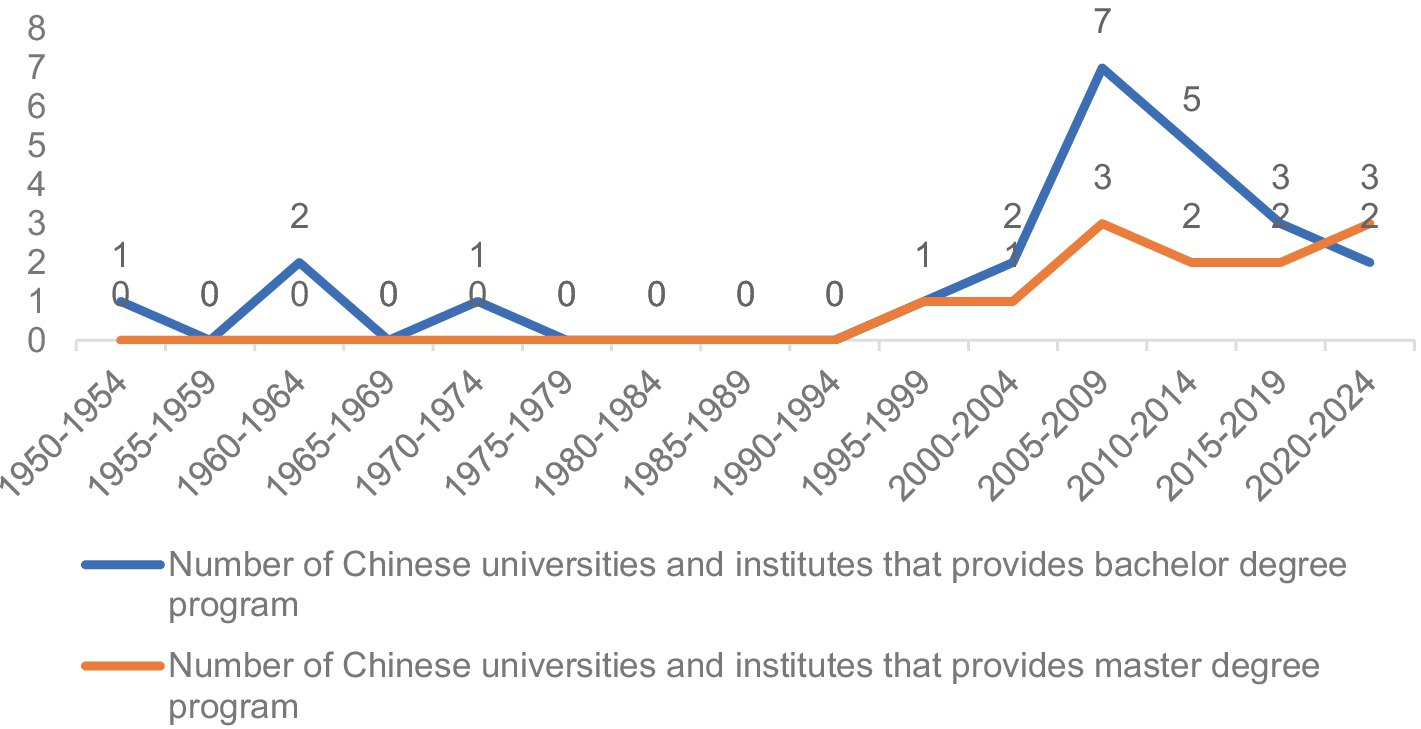
Figure 1. Number of Chinese universities and institutes that have been providing bachelor and master degree programs.
It is interesting to notice that, according to Figure 1, there were two small peaks in the time periods of 2005–2009 (when 7 higher education institutions founded an ad hoc bachelor degree program and 2 launched a three-year master degree program) and 2010–2014 (when 5 among the universities and institutes founded a relevant bachelor degree program and 3 launched a three-year master degree program).
As shown in Figure 2, we can see the provinces and autonomous cities where most higher education institutions providing Italian studies are located in Beijing (6 among universities and institutes offer an ad hoc bachelor degree program while 4 of them have master degree program). The second autonomous city with the highest number of relevant programs is Tianjin (2 bachelor degree program and 2 master degree program). This is followed by Guangdong (where you can find 2 bachelor degree program and one master degree program).

Figure 2. Distribution of Chinese universities and institutes that provide bachelor, master and PhD programs.
In other words, according the data, Beijing houses 1/4 of all Chinese universities and institutes that provide the bachelor degree program, and 1/3 that have various types of master degree programs. In terms of quantity, Beijing plays a pivotal role in the Italian language and culture teaching in Chinese higher education. Moreover, it is worth mentioning that after Beijing Foreign Studies University stopped its PhD program, since 2024, Sichuan has become the only Chinese province offering an ad hoc PhD program.
5.1.2 List of universities and institutes that have been providing Italian language and culture as elective, compulsory or minor courses (including discontinued ones)
According to the statistics provided by the Italian Institute of Culture & Cultural Office of the Embassy of the Republic of Italy in Beijing, supplemented by our own survey,13 in China there are 28 universities and institutes that have been offering or used to offer Italian language and culture as elective, compulsory or minor courses (see Table 2).

Table 2. Chinese universities and institutes that have been providing Italian language and culture as elective, compulsory or minor courses (as of 07/2024, including discontinued ones).
According to the data, there are a total of 28 universities and institutes in China (including Hong Kong and Macao) that have been offering, or used to offer, Italian elective, compulsory or minor courses. In particular, those which have a discontinued program are Southwest University (SWU 2018–2019) and East China University of Political Science and Law (ECUPL 2019–2020). Among the 26 universities and institutes in China that are currently offering some courses, it is worthy to note that both the University of Hong Kong (HKU) and NKU offer Italian language undergraduate majors as well as some Italian language elective or minor courses. As of July 2024, there are currently 24 universities and institutes that only offer Italian elective, compulsory or minor courses.
Among these 26 universities and institutes, there are 4 that are offering compulsory courses, which are generally schools that have dual degree programs with Italian universities: (1)Sichuan Normal University (SICNU), (2) Zhongnan University of Economics and Law (ZUEL), (3)Beijing University of Chemical Technology (BUCT), e (4) Northwest University (NWU).14 In addition to this, South China Business College Guangdong University of Foreign Studies offer just minor courses, which do not count as academic credit. Moreover, this college is currently preparing to open an Italian language and Culture major.
Based on the data in the table, the author also lists the following three analysis figures (Figure 3).
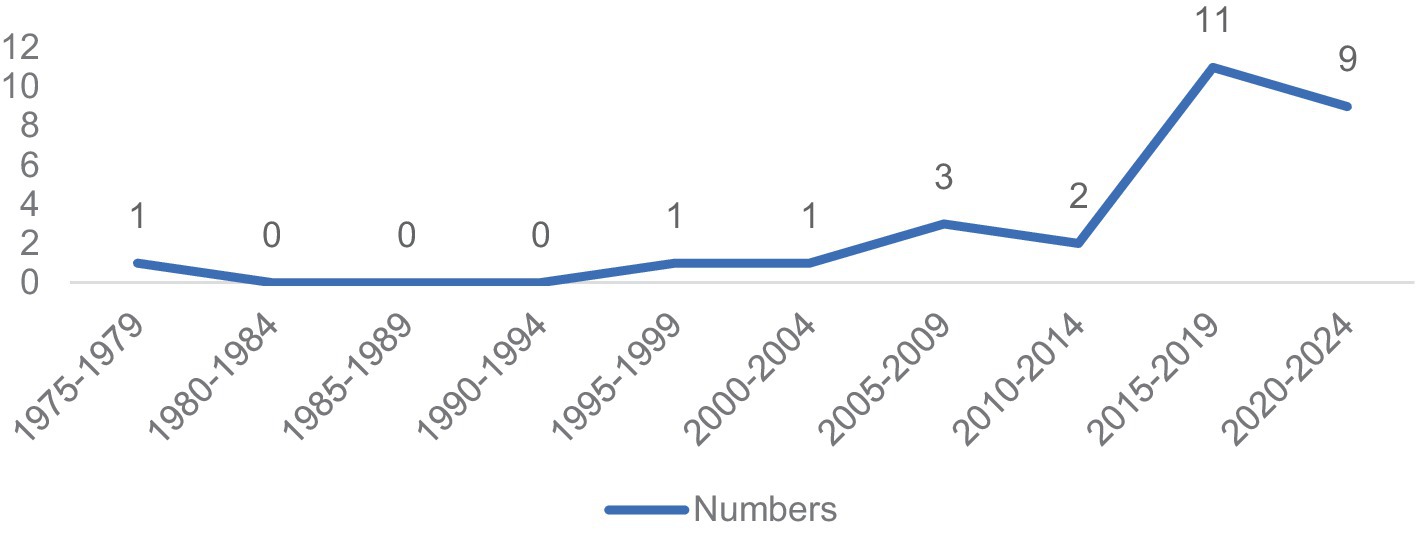
Figure 3. Number of Chinese universities and institutes that have been providing Italian language and culture as elective, compulsory or minor courses (including discontinued ones).
Regarding the course establishing timing, in 1979 or 1980, XACM launched an Italian Phonetics Course for undergraduate students in the vocal music department as a compulsory course. After that, HKU (which has been offering an Italian minor course since 1998) and the Chinese University of Hong Kong (CUHK, which opened the Italian minor course in 2004) started their respective courses.
Among the 28 universities and institutes that opened the Italian language and culture as an elective, compulsory or minor courses, 20 launched their courses and programs after 2015 (11 between 2015 and 2019 and the remaining 9 between 2020 and 2024). From these data, it is easy to observe that since 2015, the number of Chinese universities and institutes that opened some kind of Italian language and culture course has sharply increased. It is likely that in the near future more and more Chinese universities and institutes will follow this trend.
As can be seen from Figure 4, the universities and institutes that are offering different kinds of Italian language and culture courses are distributed in 12 provinces and autonomous cities. In particular, the highest number is in Beijing where 4 academic institutions provide different types of courses. On the other hand, Shaanxi, Guangdong and Hong Kong have each 3 higher education institutions providing these types of courses. In conclusion, the number of universities and institutions is more uniformly distributed across China, this is the main difference between the distribution of whole degree programs and courses in the country. Indeed, bachelor and master programs are mainly located in Beijing.
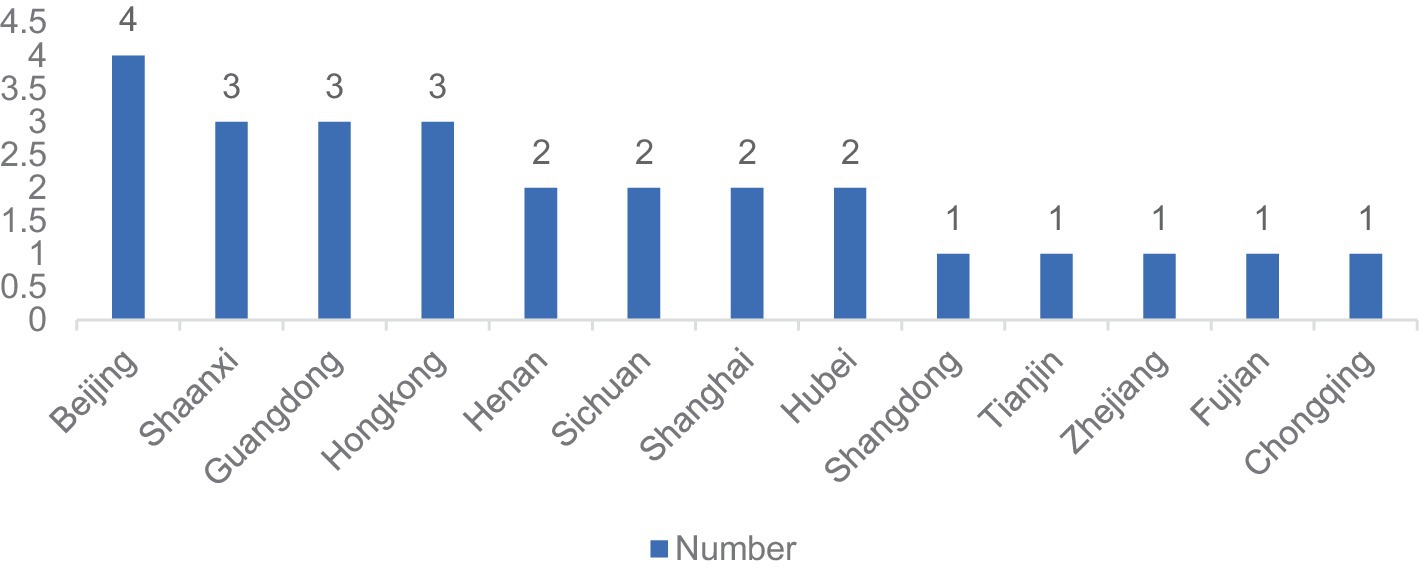
Figure 4. Distribution of Chinese universities and institutes that provide Italian language and culture as elective, compulsory or minor courses.
As shown in Figure 5, nearly a half of the universities and institutes that are currently offering various Italian language and culture courses are mainly comprehensive universities (11/26). The other universities which also offer these courses cover many specializations such as normal universities, music conservatories and institutes of technology. This does not necessary mean that the Italian courses provided are strictly related with each university specialization.
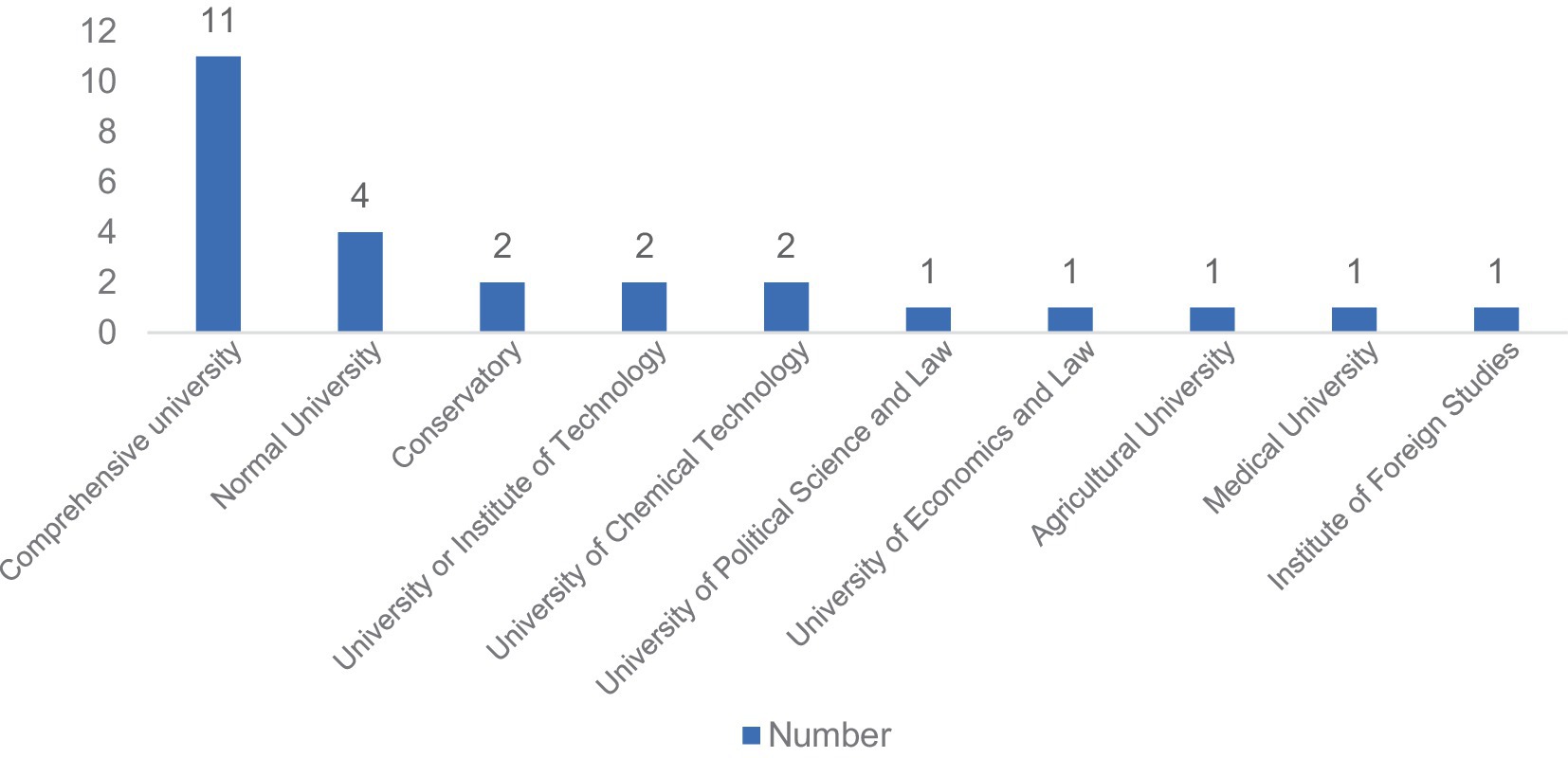
Figure 5. Types of universities and institutes that offer Italian language and culture as elective, compulsory or minor courses.
In addition, the five universities that offer compulsory Italian language courses have their own specific and, sometimes, unique programs, as shown in Table 3.
Four of these five programs are jointly provided with Italian academic institutions, which have a solid reputation in their respective fields.
5.1.3 List of vocational and technical institutes (“da zhuan”) offering Italian language majors or elective courses
According to the figures provided by the Italian Institute of Culture & Cultural Office of the Embassy of the Republic of Italy in Beijing,15 in China besides Hebei International Studies University (HISU),16 there are 4 institutions that provide a three-year Italian language short majors or offer Italian language elective courses (details in Table 4).
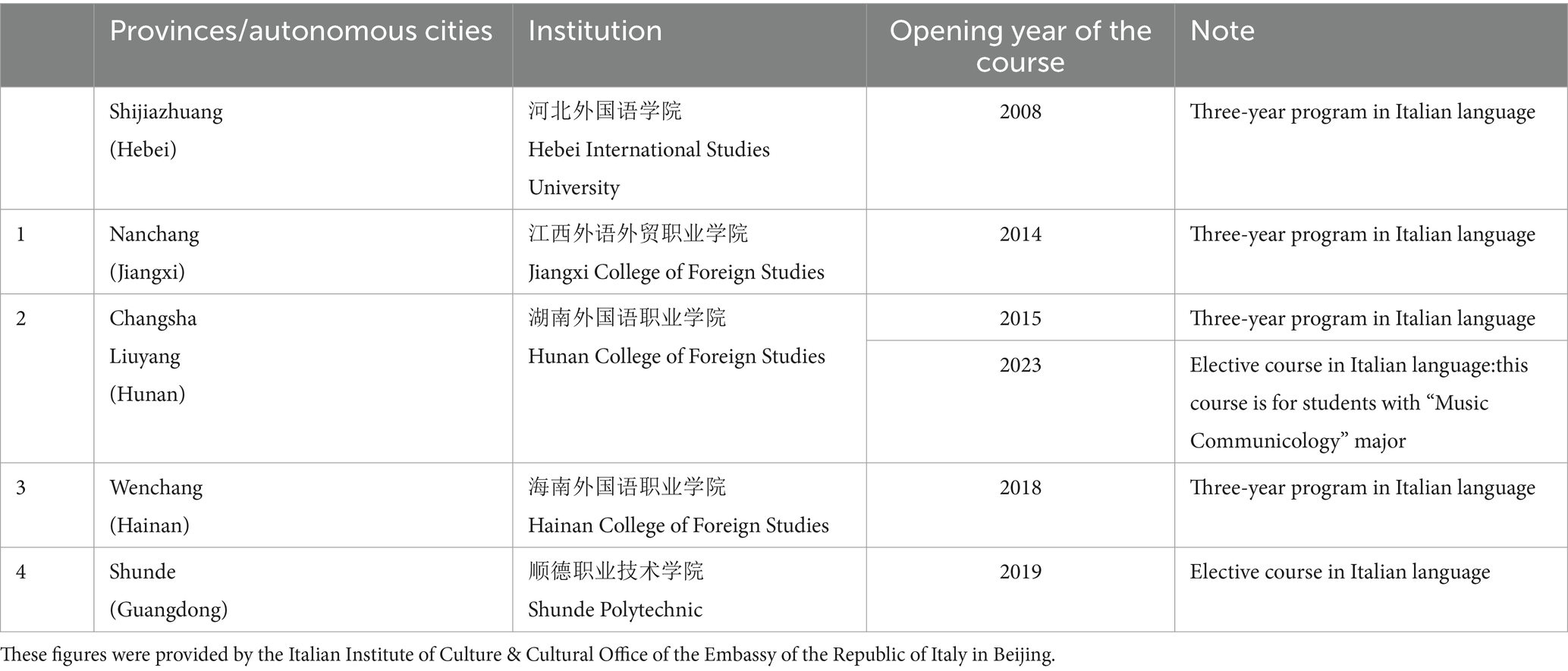
Table 4. Chinese vocational and technical institutes (“da zhuan”) offering Italian language majors or elective courses.
It should be noted that HISU has begun to recruit “da zhuan” students in Italian language since 2008. In 2014, 2 years after the aforementioned transformation, it began to recruit Italian-language undergraduate students. Since then, this institute accepts both “da zhuan” students and undergraduate students. Moreover, Hunan College of Foreign Studies (Huwai) has begun to recruit “da zhuan” students in Italian language since 2015. In 2023, it was opened an elective Italian language course for students with “Music Communicology” major. In addition to this, since 2019, Shunde Polytechnic (SDPT) opened an elective Italian language course.
Considering these data, it is clear that an increasing number of Chinese vocational and technical institutes launched their own Italian language majors or opened Italian elective courses. Consequently, we can say that the number of students learning Italian language has been increasing.
To sum up, since the launch of the first Italian language major by the then-Foreign Trade Institute (nowadays UIBE) in Chinese academia in 1954, Italian language and culture teaching has achieved a great development in Chinese higher education system. Nowadays in China there are currently 24 universities and institutes that provide Italian language majors (24 bachelor degrees, among them 12 master degrees and 1 PhD program); there are 26 between universities and institutes that offer Italian language and culture as elective, mandatory or minor courses (among these universities, HKU and NKU have both Italian language major and elective Italian language courses); there are 4 vocational and technical institutes (“da zhuan”) that offer Italian language and culture major and Italian language elective courses, furthermore, HISU recruits both undergraduate students and “da zhuan” stduents.
Apart from the three above-mentioned arrangements in the Chinese higher education system, some universities offer Italian language courses to students through other means. For example, Hubei University of Technology (HBUT, 湖北工业大学) in 2012 established an Italian language Center (in 2014 this center was renamed Hubei Italian language Test Center), this center hired Chinese and Italian teachers outside the university to provide Italian language courses for high school students and undergraduate students who wanted to study in Italy. In 2019 The College of Music of Chongqing Normal University (CNU,重庆师范大学) cooperated with the private institution Yu Hang Education语航教育 (this training center is also an Italian language Test Center) to teach Italian language to high school students and undergraduate students, laying a language foundation that can help them to study in Italy.
5.2 Analysis of the current situation of Italian language and culture teaching in China
5.2.1 Teachers’ situation
In the current situation, most of the teachers in the field of Italian language and culture teaching in higher education system are middle-aged or younger teachers, mainly between 30 and 45 years old,17 who possess higher education background.18
In fact, according to the data, there are 164 Chinese teachers who teach Italian language and culture in the universities and institutes (including vocational and technical institutes): those above 45 years old are 16 (9.75%); those in the range of 35–45 years old are 74 (45.12%); those who are 30–35 years old are 59 (35.98%); those who are younger than 30 years old are 15 (9.15%). The teachers aged 30–45 account for more than 81% of the total.19
5.2.1.1 Teachers of universities and institutes offering Italian language majors (both undergraduate and graduate level)
Professor Haihong Zhang and her team members (张海虹)—from the Italian language Department of Guangdong University of Foreign Studies (GDUFS)—conducted a survey on the educational background and academic titles of the relevant Chinese teachers of universities and institutes offering Italian majors (both undergraduate and graduate level) in 2023. The figures are summarized in Table 5.20
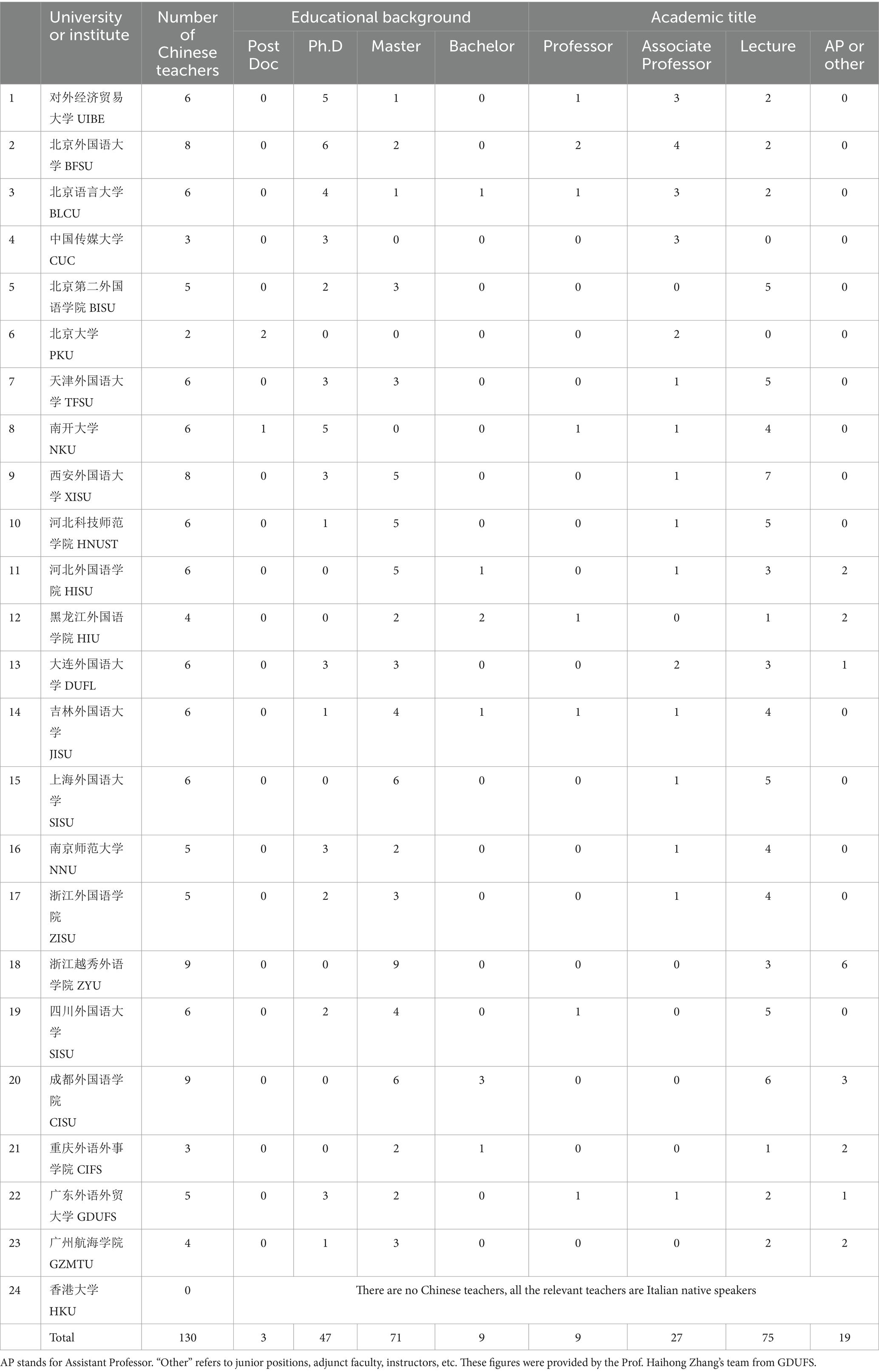
Table 5. Teachers’ educational background and professional titles of universities and institutes offering Italian language majors (as of 07/2024).
According to the data, among the 131 teachers of universities and institutes offering Italian majors (both undergraduate and graduate level): 9 full professors,21 28 associate professors, 75 lecturers, and 19 assistant professors or other (助教及以下). Among the various types of teachers, professors account for 6.92%, associate professors account for 20.76% (“senior academic title”—professors and associate professors account for 27.69% of the total number), and lecturers 57.69% (which means that “intermediate academic title” accounts for 57.69% of the total number).
Regarding geographical distribution, professors and associate professors are mainly concentrated in Beijing, with 4 professors (accounting for 44.44% of the total number),22 and 15 associate professors (accounting for 53.57% of the total). Again, it is clear that Beijing plays a very important role in Italian language and culture teaching in the country. The reasons for this phenomenon are inevitably related to the large number of relevant universities and institutes (6 in total) located in Beijing, most of which have a long history and a solid reputation in this field.
From the perspective of development through time, compared the most recent data to those of the survey results conducted by Prof. Lili from TFSU in 2010,23 at the time of the Zhi’s work, in the universities and institutes offering Italian majors (both undergraduate and graduate level), there were in total 73 teachers, of whom 10 were professors (13.7%), 15 associate professors (20.5%), 23 lectures (31.5%), 25 assistant professors or others (34.2%).
In general, after 14 years of development, the number of teachers in the universities and institutes offering Italian majors has expanded a lot, the number of associate professors and lecturers has increased significantly (associate professors from 15 to 27, the lecturers from 23 to 75). On the other hand, the number of assistant professors and other types of teachers has decreased (from 25 to 19).24 Moreover, the percentage of lectures has increased a lot (from 31.5 to 57.69%) and the percentage of assistant professors and other teachers has decreased a lot (from 34.2 to 14.6%). All things considered, the overall quality of the teachers has been improved during these years.
However, there is an occurrence that deserves attention, that is, the decreased number of full professors from 10 to 9 (of whom 3 are retirees) and the consequent decrease in the proportion (from 13.7 to 6.9%). There are two reasons behind this situation: on the one hand, many old professors with rich experience in teaching and research have retired one after another in these years due to age limits; on the other hand, the younger teachers who were able to become full professors are relatively few. Nevertheless, considering that the Italian language teachers are mainly middle-aged and young (about 80% is between 30 and 45 years old), there is still great potential for promotions in the future.
Regarding teachers’ educational background, there are 3 postdoctoral fellows, 47 doctors, 71 master holders (some of them are currently enrolled in a PhD program), and 9 bachelor holders. The statement that more and more teachers will obtain doctoral degrees in the future is an educated guess, and one that we believe in.
5.2.1.2 Teachers of universities and institutes providing Italian language and culture as elective, compulsory or minor courses
In July 2024, a comprehensive survey was conducted on the academic titles and educational background of Chinese teachers of universities and institutes offering elective, compulsory or minor Italian courses, the figures are as follows in Table 6.
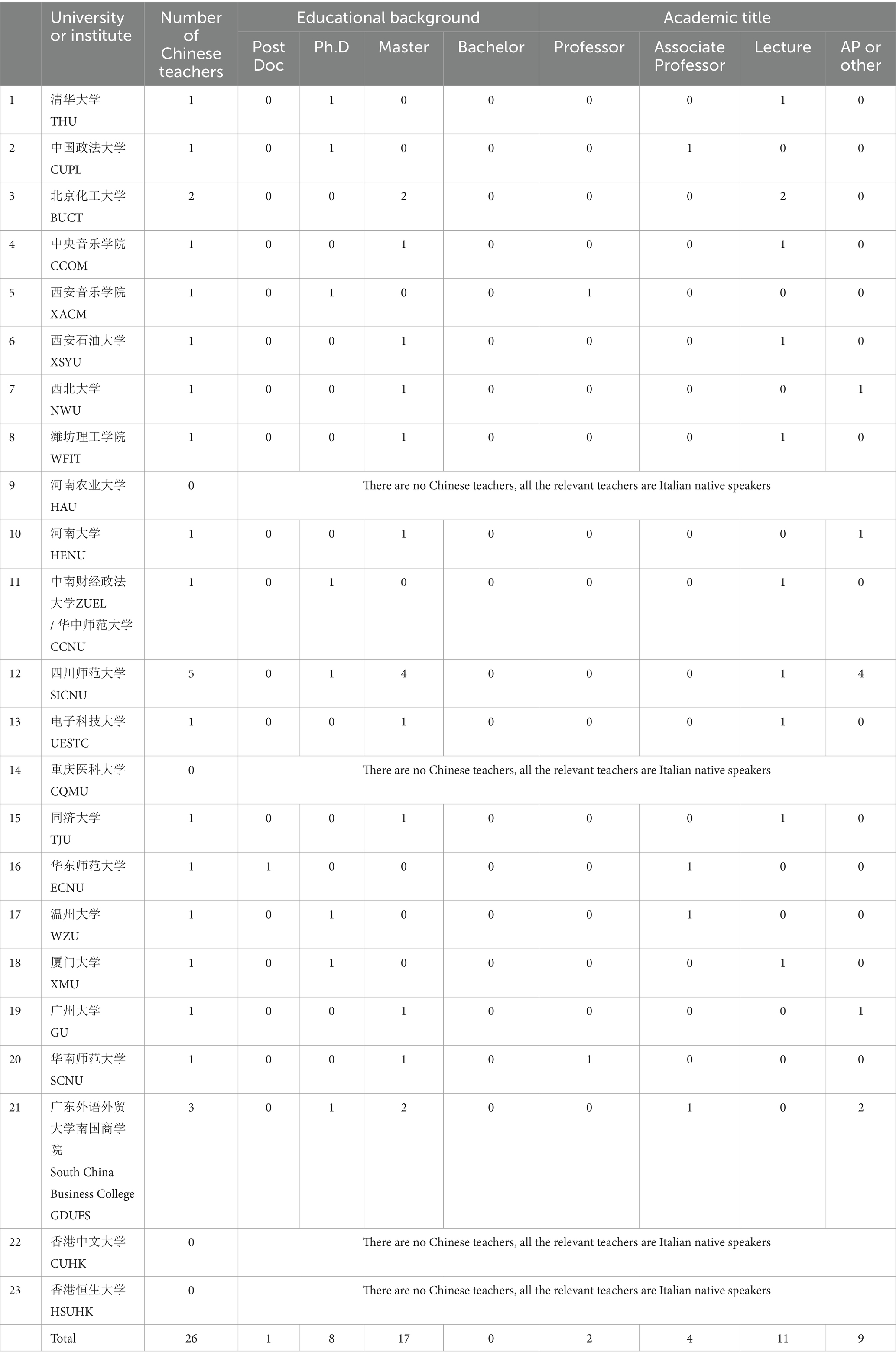
Table 6. Chinese universities and institutes offering Italian language and culture an elective, compulsory or minor courses (as of 07/2024).
According to the data, among the 26 teachers of universities and institutes that provide elective, compulsory or minor Italian courses: there are only 2 full professors,25 4 associate professors, 12 lecturers, and 8 assistant professors or other kinds of teachers. Among the teachers, professors account for 7.69%, associate professors account for 15.38% (“senior academic title”)―professors and associate professors account for 23.07% of the total number―, and lecturers 46.15% (i.e., “intermediate academic title”) account for 46.15% of the total. From these data, we can see that the proportion of teachers with senior and intermediate academic titles who teach Italian language as a mere subject is slightly lower than that those who teach Italian in institutions offering Italian majors (“senior professional titles” account for 27.69% of the total number of teachers; “intermediate professional titles” account for 57.69% of the total). Nonetheless, this difference is relatively marginal. In terms of the teachers’ educational background, there is 1 holding a postdoc, 8 doctors, 17 master holders (some of them currently perusing a PhD). It is an educated guess to state that more and more teachers will hold doctoral degrees in the future.
In addition to this, during the investigation, the author also noticed a phenomenon: unlike the institutions that offer Italian majors usually have a complete team of teachers,26 institutions that only provide different kinds of courses usually hire few teachers. In particular, 11 of these universities have only one Chinese teacher and no Italian teacher such as Tsinghua University (THU), Tongji University (TJU);27 4 of these universities have only Italian teachers without any Chinese teacher (HAU, CQMU, CUHK, and HSUHK). Only 8 institutions are equipped with both Chinese and Italian teachers,28 among them the Chinese teacher and Italian teacher from XACM and ZUEL are responsible for different types of courses.29
The lack of Italian teachers means that students in these institutions cannot get good oral training, which will deeply affect their speaking level, daily communication and listening skills. On the other hand, the lack of Chinese teachers means that students may not be able to be guided properly into understanding Italian grammar.30 Anyway, it is suggested that institutions lacking of a complete teaching team are partially understaffed and this has a slightly negative impact on teaching.
5.2.1.3 Teachers of vocational and technical institutes (“da zhuan”) offering Italian language majors or elective courses
In July 2024, a survey on the educational background and academic titles of Chinese teachers of vocational and technical institutes (“da zhuan”) offering Italian language majors or elective courses was conducted, the figures are as follows in Table 7.
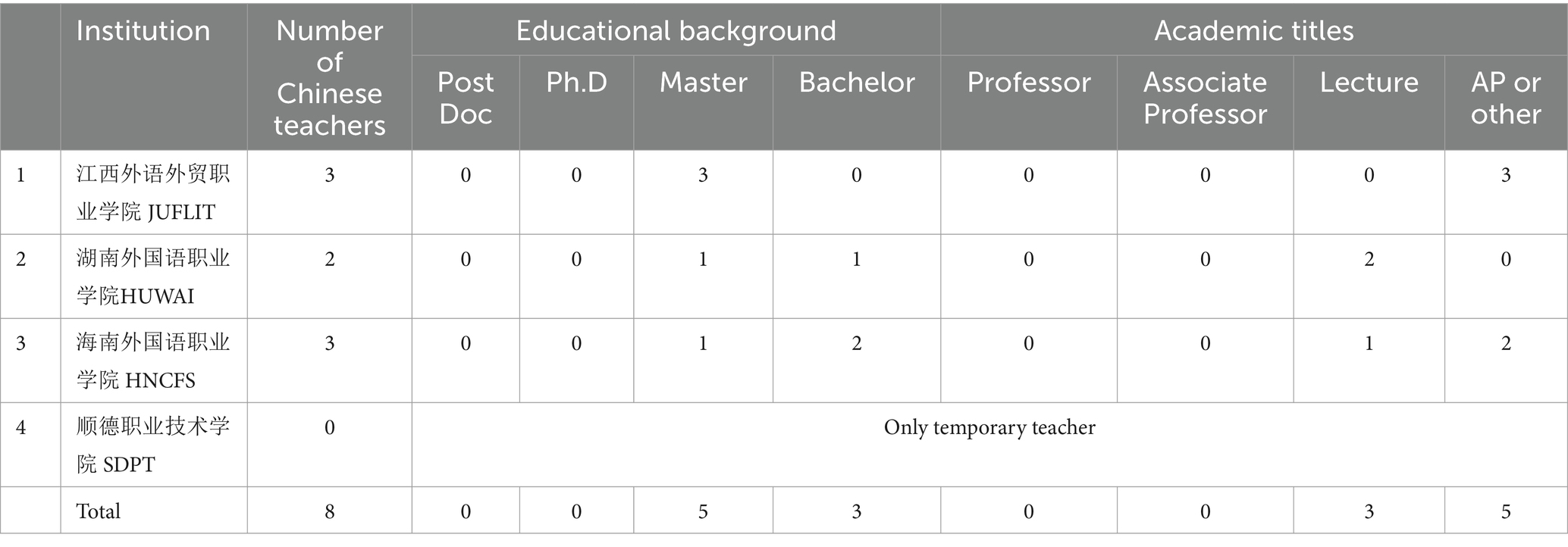
Table 7. Chinese vocational and technical institutes (“da zhuan”) offering Italian language majors or elective courses (as of 07/2024).
According to the data, among the 8 teachers of vocational and technical institutes (“da zhuan”): there are 3 lecturers31 and 5 assistant professors and other types of teachers. Teachers with “intermediate academic title” account for 37.5% of the total number. In terms of the teachers’ educational background, there are 5 who hold a master degree and 3who only hold a bachelor degree.
The results of the survey show that there is no professor or associate professor among the teachers of vocational and technical institutes, and no teacher holds a doctoral degree. Therefore, it is evident that these teachers’ academic qualifications are below the average. It is worth mentioning that except for Shunde Polytechnic (SDPT, that has no fixed teachers),32 the other three institutions all have a complete teaching team, including both Chinese and Italian teachers.
In conclusion, the group of Italian teachers in China is constantly expanding, more and more young teachers have obtained or are pursuing doctoral degrees to improve their academic qualifications and research capabilities. It is fair to assume that the teaching level will keep improving in the near future.
5.2.2 Course curricula and teaching materials
To recapitulate, for the purpose of this research, we considered three kinds of “higher education institutions”: (1) universities and institutes offering Italian language Majors (both undergraduate and graduate level); (2) universities and institutes offering Italian language and culture as elective, compulsory or minor courses; (3) vocational and technical institutes (“da zhuan”) offering various types of programs.
5.2.2.1 Course curricula and teaching materials of universities and institutes offering Italian language majors (both undergraduate and graduate level)
5.2.2.1.1 Course curricula and teaching materials for undergraduate students
These are the programs with a longest tradition in China, consequently they follow a kind of relatively well-established pattern. These courses can ensure that students master the basic skills of Italian language listening, speaking, reading and writing abilities.
As a way of example, we can refer to the core courses of the Italian language undergraduate program of NKU formulated in September 2022 (Table 8).
As we can see from the table above, these courses can be divided into two categories: core courses and complementary courses:
(1) Core courses:
First year: “Italian language basics (elementary level)” series of courses (grammar, listening, speaking and comprehensive courses, etc.);
Second year: “Italian language basics (intermediate level)” series of courses (grammar, listening, speaking, reading, writing and comprehensive courses, etc.);
Third and fourth years: “Advanced Italian language” series of courses (grammar, writing, translation, interpretation and comprehensive courses, etc.).
(2) Complementary courses:
A Brief Introduction of Italy, A brief introduction of Italian literature, Business Italian language, Italian for Tourism, etc.
The core courses focus on cultivating students’ foreign language skills (listening, speaking, reading, writing, translation, etc.), which weight for the majority of the program. The complementary courses focus on increasing students’ knowledge of Italian culture and in other uses of language for specific purposes such like economics, business, tourism, academic research, etc.
Different universities and institutes also have slightly different curricula for their equivalent respective programs: for example, the UIBE also provides subjects such as international business negotiations in Italian, Italian business correspondence, etc.
Considering that undergraduate freshmen in China have, usually, no previous Italian knowledge,33 all universities and institutes put their emphasis on grammar teaching and basic foundation of the language skills.
Teaching materials
At present, there are many Italian textbooks available in China depending on the course type. Consequently, teachers can flexibly choose teaching materials.
Regarding basic courses of language skills: the most frequently used textbooks are Studiamo l’italiano all’università (We study Italian at the University [our translation] 大学意大利语教程) and Nuovissimo Progetto Italiano (Brand New Italian Project [our translation] 新视线意大利语). Other popular alternatives are, as a way of example, Corso intensivo d’italiano (Intensive Italian course 速成意大利语) and Ciao! (Hello! 你好!意大利语). Some of these textbooks are directly written by Chinese scholars, while others are popular overseas textbooks translated and edited by Chinese professors.
In addition, there are many textbooks that can be used for teaching Italian for specific purposes such as: (1) business and economics teaching materials,34 (2) Italian literature teaching materials;35 (3) Italian history teaching materials; 36 (4) Italian cultural teaching materials.37 In addition to this, there are also a corpus of ad hoc teaching material compiled by various teachers for their respective courses that, although is available to the student and the relevant staff, is largely unpublished.
In general, there is plenty of undergraduate textbooks, and students can use these textbooks by themselves to improve their Italian language skills and expand their relevant knowledge.
5.2.2.1.2 Course curricula and teaching materials for graduate students
The 12 universities and institutes that offer graduate courses have four different specializations: (1) European Language and Literature 欧洲语言文学 (three-year program), (2) Italian-Chinese and Chinese-Italian Interpretation 意大利语口译 (MTI, two-year program), (3) Italian-Chinese and Chinese-Italian Translation 意大利语笔译 (MTI, two-year program), and (4) Area studies (three-year program). Each university and institute has its own teaching peculiarities and qualities, so their core courses are partially different, as summarized in Table 9.
Teaching materials
Since the courses and the peculiarities of each program are different, teachers, apart from material compiled by themselves, usually choose domestic and foreign textbooks according to the content of their own courses and their preferences.38
In the questionnaire, many teachers also highlighted that some graduate-student courses lack ad hoc textbooks. These subjects include: “Italian Art History,” “Italian Modern and Contemporary Literature,” “Business Translation,” “Comparison of Chinese and Italian Culture,” “Italian-Chinese and Chinese-Italian Translation Practice,” “Writing,” etc.
5.2.2.2 Course curricula and teaching materials of universities and institutes providing Italian language and culture as elective, compulsory or minor courses
For universities and institutes that provide Italian elective, compulsory or minor courses, each school has its own tailored program, which varies greatly. Thanks to a questionnaire results, information about 15 universities and institutes were collected. The relevant data are reported in Table 10.

Table 10. Course curricula of universities and institutes providing Italian language and culture as elective, compulsory or minor courses.
Compared with universities and institutes that offer Italian majors, those that offer other types of courses have shorter ones (most courses last only 1 semester, and the longest one lasts for 4 semesters). After completing these courses, most students can only reach the elementary level (from very beginner to A2). However, a part of students cannot reach even A1 level due to the limited study time. On the other hand, a limited number of students who take some relevant elective courses (such as THU-Italian language 3, CUPL-Italian language at university) can reach the intermediate level B1 and, in few cases (attending courses such as SICNU-Italian language about product design), even B2.39
In addition to this, unlike the Italian language majors, which have basically stable curricula, the elective, compulsory or minor courses were often amended. For example, the following universities have experienced curricula changes (Table 11).
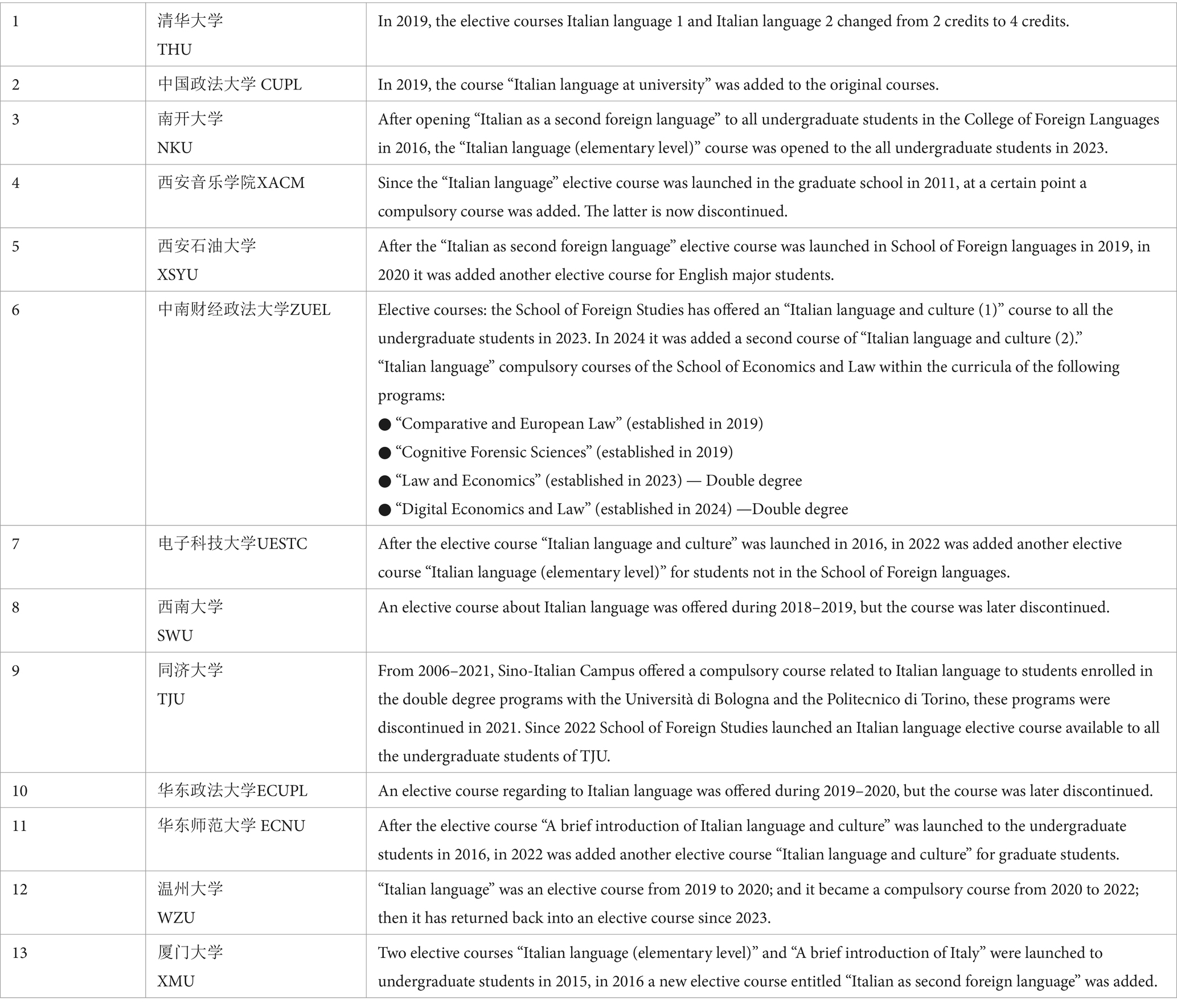
Table 11. Course changes of universities and institutes providing Italian language and culture as elective, compulsory or minor courses.
As can be seen from the table above, for universities and institutes that offer Italian elective, compulsory and minor courses, there are often some changes, such as canceling courses, adding new courses for different groups of students (undergraduate or graduate students), transforming the type of courses (from elective to compulsory, or vice versa), increasing or decreasing course hours (credit change), etc.
Teaching materials
Compared with the rich and diverse teaching materials for Italian majors, institutions offering different kinds of Italian language and culture courses face the challenge of the lack of suitable teaching material.
Most teachers use the textbooks Studiamo l’italiano all’università and Nuovissimo Progetto Italiano that are designed for Italian major students. However, these two textbooks are not suitable for the students of elective, compulsory and minor courses because they are tailored for longer courses.
Moreover, at the very beginning of Italian courses, teachers have to spend a lot of time to explain the pronunciation rules, so some teachers also use the textbooks such as Guida alla lingua italiana (Guide to the Italian language [our translation] 意大利语入门) and Fonetica italiana (Italian phonetics[our translation] 意大利语语音快速突破).
Besides, teachers will also choose other teaching textbooks, such as Il corso in italiano (The course in Italian [our translation]走遍意大利), Corso intensivo d’italiano (Intensive Italian course [our translation] 速成意大利语), Italian language from zero [our translation] (零起点意大利语), etc. Furthermore, as usual, teachers also prepare and arrange ad hoc teaching material by themselves.
It is worth mentioning that Professor Ling Zhou周玲of HACM,―when she taught the compulsory course “Italian Phonetics” for undergraduate students of the vocal music department―used her musical knowledge and wrote the textbook La pronuncia italiana (Italian Pronunciation [our translation] 意大利语语音). To sum up, it is an urgent issue to publish suitable textbooks for elective, compulsory and minor courses of Italian.
5.2.2.3 Course curricula and teaching materials of vocational and technical institutes (“da zhuan”) offering Italian language majors or elective courses
The Italian language major in vocational and technical institutes belongs to the “applied foreign language major” (应用外语专业), compared with the Italian language major in the universities and institutes, the teaching methodology and curricula setting are different.
Regarding the program duration, the vocational and technical institutes are all “three-year programs,” so they are 1 year shorter than the traditional “four-year programs” of universities and institutes. Regarding to programs’ content, the vocational and technical institutes are more practical and business oriented. Taking the Italian language major in the Hunan College of Foreign Studies (Huwai) as an example, the professional training goal is to “cultivate cross-border e-commerce Italian language speakers.” The course program is “Basics of Italian language plus professional knowledge of cross-border e-commerce.”
The main courses are as follows: Italian language basics (基础意大利语), Multimedia-based Italian listening and speaking course (意大利语视听说), Multimedia-based Business Italian listening and speaking course (商务意大利语视听说), Spoken Italian in the workplace (职场意大利语口语), Business Italian language (商务意大利语), Business Correspondence in Italian (商务意大利语函电), Business Italian Translation Practice (商务意大利语翻译实务), International Business Management (Bilingual) (国际商务管理—双语), Cross-border E-Commerce practice (跨境电子商务实务), Cross-border e-commerce operation and marketing (跨境电商运营与推广), etc. In short, from the name of the subjects, it is clear that this kind of programs pays more attention to the “practicality” and rules out courses about Italian literature, history, etc.
Teaching materials:
Regarding the textbooks, teachers also use Studiamo l’italiano all’università, Nuovissimo Progetto Italiano and Il corso in italiano; in other courses teachers use textbooks such as Corrispondenza Commerciale e Testi Autentici (Commercial Correspondence and Authentic Texts [our translation]意大利语经贸应用文), Affare fatto! Corso d’italiano aziendale (Deal! Business Italian course [our translation]新视线商务意大利语初级教程) as teaching materials, as well as some teaching material collected by the teachers themselves.40
5.2.3 Students’ number
5.2.3.1 Students’ number of universities and institutes offering Italian majors (both undergraduate and graduate level)
According to the figures provided by Professor Haihong Zhang’s team from GDUFS in 2023, the student numbers of universities and institutes offering Italian majors are as follows (Table 12).
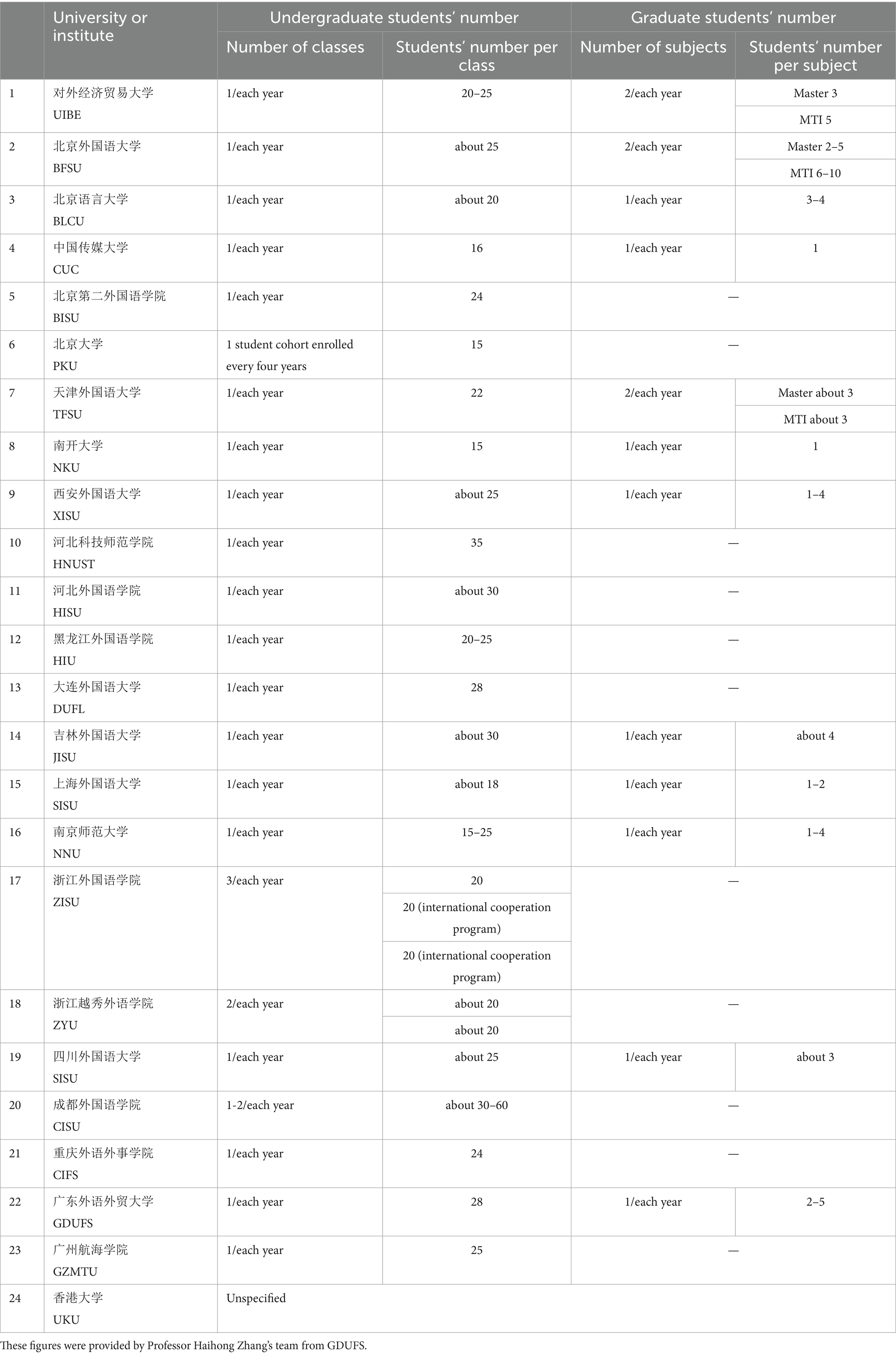
Table 12. Students’ number of universities and institutes offering Italian majors (both undergraduate and graduate level).
According to the data, there are about 600 undergraduate and 50 graduate students of Italian related majors graduate each year. In general, these students have a solid foundation of Italian language and are considered reaching B2 or C1 of Italian CEFR level.41 Thanks to the hard work of several generations of Italian teachers, now there are a large number of Italian speakers that work in many fields in our country, such as government, foreign trade, education, tourism, media, etc. In recent years, with the increasing demand of the society for qualified experts such as “foreign language plus another major,” more and more Italian language graduates choose to go abroad or to other universities to continue to broaden their horizons, enrich their knowledge in other fields such as law, economy, music, etc. and strive to become an employee with a better overall preparation. In conclusion, these students can use their language advantages in various fields to make their own contribution to further develop of our country.
5.2.3.2 Students’ number of universities and institutes providing Italian language and culture as elective, compulsory or minor courses
Different institutions have different programs for elective, compulsory or minor courses that tend to change (such as adding classes, canceling courses, etc.) quite often. Furthermore, the number of students taking the same course fluctuates each year consequently it is difficult to interpret the data and find consistent patterns through time.
The data collected through a questionnaire from a sample of 15 universities or institutes are reported in Table 13.

Table 13. Students’ number of universities and institutes providing Italian language and culture as elective, compulsory or minor courses.
According to the data of 15 universities and institutes that completed the aforementioned questionnaire, there are about 2,000 students who choose the Italian language as elective, compulsory or minor course each year. Therefore, we can infer that in the 26 institutions in China, the students should reach the average number of 3,500 unit (the range is between 3,000–4,000 students).
Students who take these kinds of courses are in the so-called “major plus foreign language.” This means that their major may virtually be any of those available (from physics to music, from law to medicine, etc.). In fact, the underlying principle is that learning Italian language can equip them with other skills outside of the domain of their chosen profession.
However, since the course hours are usually very few, students cannot reach a high proficiency level. The realistic expectation is that the majority of them can only reach the elementary level (A1, A2), and only a few can achieve the intermediate level (B1, B2). In the later stage, if students want to go to Italy to continue their studies, they often need to study by themselves Italian language independently from the university courses that are provided.
In any case, there is no doubt that the opening of these kind of courses is somehow beneficial. Indeed, the aforementioned courses have greatly increased the number of students that learn Italian language and are interested in Italian culture.
5.2.3.3 Students’ number of vocational and technical institutes (“da zhuan”) offering Italian language majors or elective courses
According to the data collected for this paper, the number of students in vocational and technical institutes are as follows (Table 14).
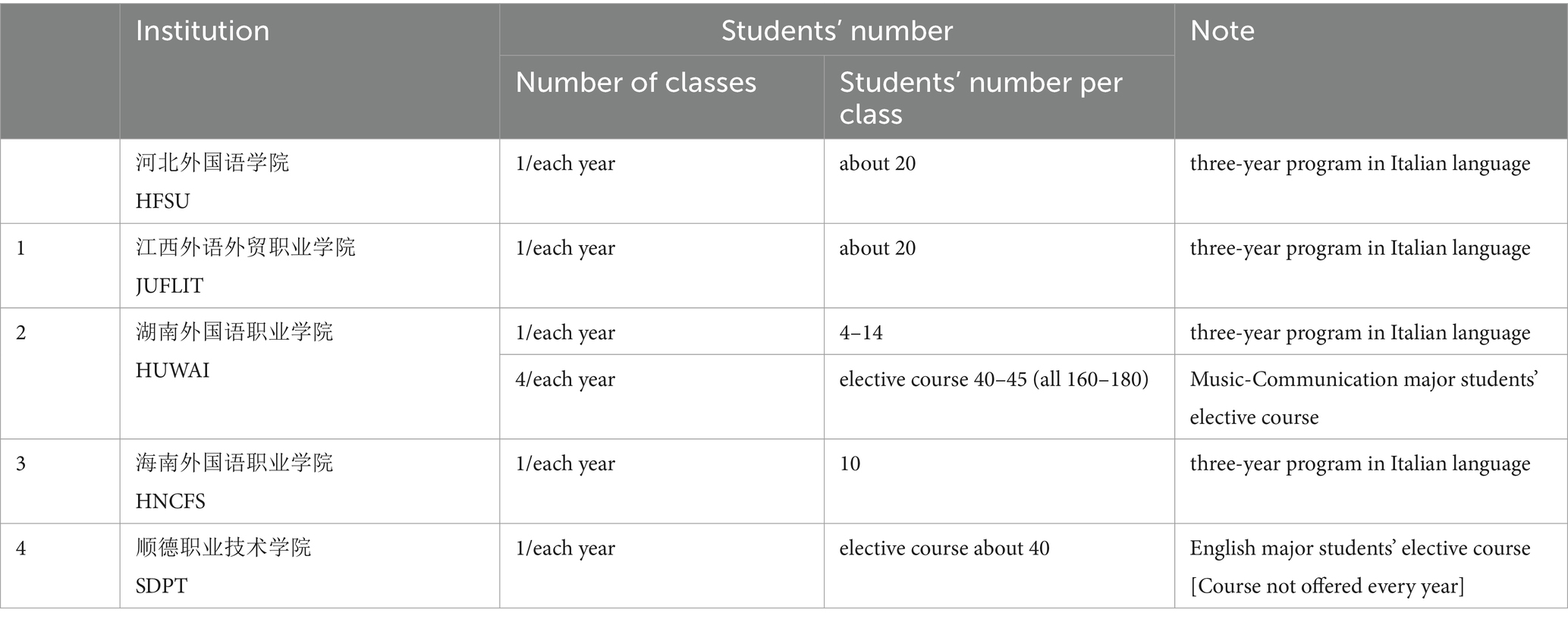
Table 14. Students’ number of vocational and technical institutes (“da zhuan”) offering Italian language majors or elective courses.
According to the data, each year, there are about 60 students graduating in an Italian language major and around 200 students choosing elective courses in this kind of institutes. The students’ number is relatively lower than those choosing more traditional academic education in the equivalent field. On the one hand, the number of alumni of “da zhuan” institutions amounts to the vast majority of the Italian-speaking employees in the e-commerce field. On the other hand, the elective courses offered by these institutions can give students the opportunity to learn Italian language and culture.
5.2.4 Difficulties encountered by teachers and some of their solutions
Teachers usually encounter various difficulties in the process of teaching and research. Some problems are normally solved through their own efforts, but some problems are not directly related to their teaching skills. It goes without saying, that different groups of teachers encounter different problems. The following sections will explore in detail the kind of issues faced according to the kind of higher-learning institution type.
5.2.4.1 Typical difficulties (and their solutions) related to universities and institutes offering Italian majors (both undergraduate and graduate level)
One of the questionnaires submitted for our research dealt with problems and some solutions provided by the staff teaching in universities and institutes offering Italian majors (both undergraduate and graduate level), the results are shown in Table 15.
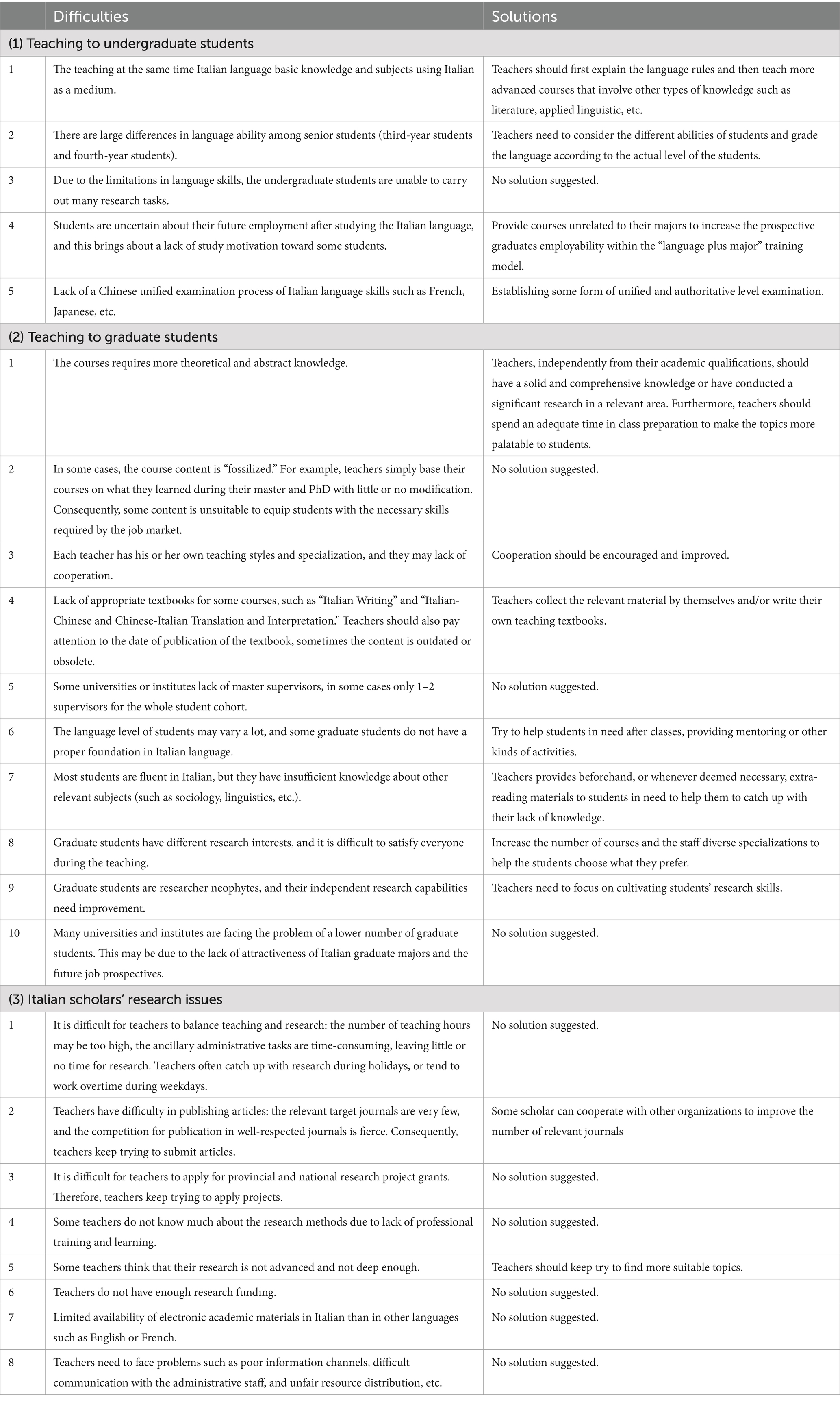
Table 15. Typical difficulties (and their solutions) related to universities and institutes offering Italian majors (both undergraduate and graduate level).
Teachers themselves should work hard to improve their teaching and research abilities, but many of these problems cannot be solved by teachers alone. Indeed, some problems―such as “insufficient enrollment of graduate students,” “poor information channels, difficult communication with the administrative staff, unfair resource distribution,” etc.,― need to be solved from the university level or even the social level.
5.2.4.2 Typical difficulties (and their solutions) related to universities and institutes providing Italian language and culture as elective, compulsory or minor courses
In terms of teaching, the difficulties and problems encountered by teachers of these kinds of courses are different from those of teachers of Italian language majors. Problems and solutions can be summarized as follows in Table 16.
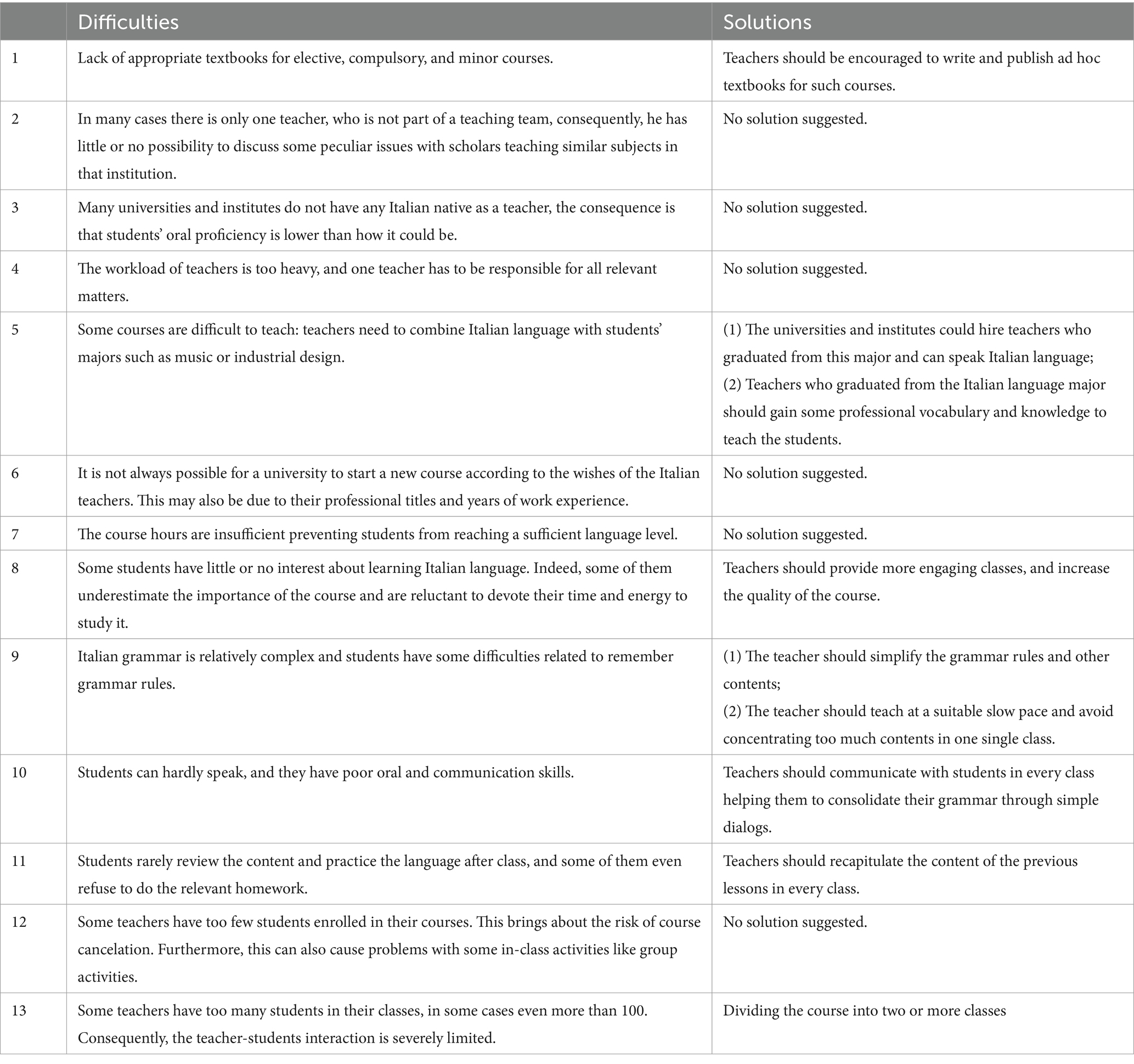
Table 16. Typical difficulties (and their solutions) related to universities and institutes providing Italian language and culture as elective, compulsory or minor courses.
Regarding academic research questions, the problems faced by teachers of this kind of courses are almost identical to those faced by teachers of Italian language major.
5.2.4.3 Typical difficulties (and their solutions) related to vocational and technical institutes (“da zhuan”) offering Italian language majors or elective courses
Teachers in vocational and technical institutes face their own peculiar problems and try to provide ad hoc solutions. The questionnaire’s results are shown in Table 17.
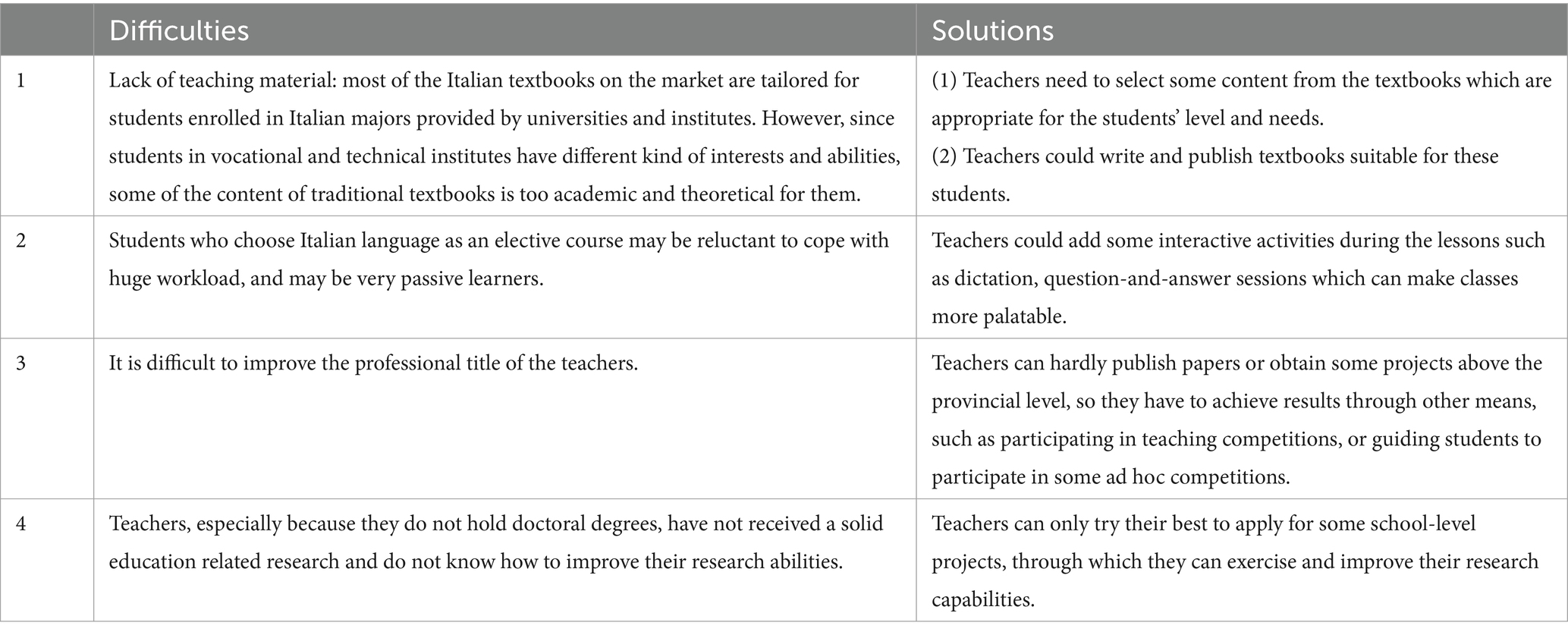
Table 17. Typical difficulties (and their solutions) related to vocational and technical institutes (“da zhuan”) offering Italian language majors or elective courses.
To sum up, in terms of research, both teachers from universities or institutes, and teachers from vocational and technical institutes are faced with the problems of difficulty in publishing articles, difficulty in applying for research projects, and the urgent need to improve their own research abilities.
6 Conclusion
In general, over the past 70 years, Italian language and culture teaching has gone through a great process of development. Thanks to the support of the Chinese Government, of the Italian Embassy in China42 and the efforts of generations of Italianists and scholars remarkable results have been achieved. Among the 24 universities and institutes that are offering Italian majors, 11 are listed as “national first-class majors”: BFSU, BLCU, UIBE, XISU, SISU, TFSU, SISU, GDUFS, NKU, DUFL, PKU; four are listed as “provincial first-class majors”: CUC, HNUST, JISU, BISU; and 2 are listed as “school first-class majors”: CISU, ZISU. Furthermore, an increasing number of universities and institutes are offering Italian language as elective, compulsory and minor courses, and more and more vocational and technical institutes are offering Italian language majors or elective courses.
Author contributions
SG: Investigation, Writing – review & editing.
Funding
The author(s) declare that financial support was received for the research and/or publication of this article. This work was supported by Zhongnan University of Economics and Law.
Conflict of interest
The author declares that the research was conducted in the absence of any commercial or financial relationships that could be construed as a potential conflict of interest.
Publisher’s note
All claims expressed in this article are solely those of the authors and do not necessarily represent those of their affiliated organizations, or those of the publisher, the editors and the reviewers. Any product that may be evaluated in this article, or claim that may be made by its manufacturer, is not guaranteed or endorsed by the publisher.
Supplementary material
The Supplementary material for this article can be found online at: https://www.frontiersin.org/articles/10.3389/feduc.2025.1466508/full#supplementary-material
Footnotes
1. ^See the official website of the Ministry of Education of the People’s Republic of China at http://www.moe.gov.cn/jyb_zzjg/huodong/202411/t20241109_1161420.html.
2. ^See the official website of Quirinale at https://www.quirinale.it/elementi/122871.
3. ^The preparatory stage (1949–1954): after the foundation of the PRC in 1949, the country sent a group of young students to study languages abroad with the objective of understanding and communicating with the world, among them were students studying Italian. (2) The initial stage (1954–1966): in 1954, the then-Foreign Trade Institute (the predecessor of UIBE) launched the first Italian language major in China. Before the Cultural Revolution, there were only three universities and institutions offering Italian majors. (3) The recovery stage after the Cultural Revolution (1970–1978): After 1970, the universities and institutions gradually resumed enrolling Italian language students which was interrupted by the Cultural Revolution, and new schools began to offer Italian majors. (4) The rapid development stage after the Chinese economic reform (1978–2011): After the Chinese economic reform, the scale of Italian language teaching began to expand. As of 2011, 14 universities and institutions have opened Italian majors and provided elective, compulsory, or minor courses.
4. ^Lili Zhi, The History, Current Situation and Development of Italian Language Teaching in China (our translation), Journal of Hubei TV University [J], December 2011, pp. 115–116. (职莉莉,中国意大利语教学的历史、现状与发展,《湖北广播电视大学学报》, 2011年12月,115至116页。).
5. ^Qian Zhang, Analisi dello sviluppo e delle caratteristiche dei manuali redatti in Cina per l’insegnamento dell’italiano, Thesis of Master Degree of Beijing Foreign Studies University, May 2018, pp. 25–26. (张倩,中国高校意大利语专业本土基础教材的演进与特点,北京外国语大学硕士学位论文, 2018年5月,25至26页。).
6. ^It was not until 2001, another institute, the CUC resumed the enrollment of students in Italian major until 2001.
7. ^Professor Ling Zhou 周玲, currently teaching Italian phonetics course at Xi’an Conservatory of Music, suggested this period of time. She is unable to pinpoint a more specific date.
8. ^Professor Xiuying Zhao 赵秀英 (1945-) after graduation from the Foreign Trade Institute (nowadays UIBE), worked in Beijing Language Institute from 1972. Since 1972 to 1983, she was responsible for teaching Chinese language to Italian bursary students who were sent to China by the Italian government. From 1983, she began to teach Italian language to Chinese students who were sent and sponsored by the Chinese government to study in Italy. The latter students studied at MOE Training Center for Overseas Study (part of the Beijing Language Institute), a center affiliated to the Ministry of Education of the PRC. Only in 2009 BLCU offered the first bachelor’s degree in Italian language study. The following year, considering the success of the undergraduate program, an analogous master degree was established. In 2014, thanks to the efforts of Professor Xiuying Zhao, BLCU and the University of Modena (Italy) began a cooperation related to the doctoral students. This program consists in sending outstanding Chinese students to pursue a PhD at the University of Modena and Reggio Emilia.
9. ^“da zhuan” institutes大专院校, refers to a type of institution that provides vocational and technical education. The duration of study is usually 3 years, after graduation the students can obtain a “da zhuan” diploma.
10. ^It is important to note that under the English name ‘university’ [in Chinese ‘大学’ “da xue”] you can find several ‘学院’ “xue yuan,” which means “institute” or ‘college’. Although the official English name is ‘university’ they retain a different Chinese name. Chongqing Institute of Foreign Studies (重庆外语外事学院) is the only one to retain the Chinese name in the translation. The other 8 institutes which are officially called universities in English are: Beijing International Studies University (北京第二外国语学院), Hebei Normal University of Science and Technology (河北科技师范学院), Zhejiang Yuexiu University (浙江越秀外国语学院), Chengdu International Studies University (成都外国语学院), Zhejiang International Studies University (浙江外国语学院), Hebei International Studies University (河北外国语学院), Heilongjiang International University (黑龙江外国语学院) and Guangzhou Maritime University (广州航海学院).
11. ^Within these 12 higher education institutions:◎ 3 institutions offer both an MTI and a 3 year master program in Italian language and culture (UIBE, BFSU, TFSU).◎ 6 institutions offer only a 3 year master program in Italian language and culture (BLCU, XISU, SISU, NNU, SISU, GDUFS).◎ JISU only provides an MTI.To this group of 10 universities and institutes, we should also mention 2 universities (NKU and CUC) which, although do not have an Italian language and culture ad hoc program, launched their master’s degree within “Area Studies” which also covers, among other things, some aspects of Italian language and culture.
12. ^Among these six students, the two students who received their doctoral degrees the latest passed their thesis discussion in 2020.
13. ^These figures were provided by the Italian Institute of Culture & Cultural Office of the Embassy of the Republic of Italy in Beijing (covering till June 2023). The author supplemented the data of “Year that opened the Italian language and culture as an elective, minor or compulsory courses” and updated some data in July 2024.
14. ^The situation at Zhongnan University of Economics and Law is a bit more complex: until July 2024, the ZUEL-SUR School of Law and Economics has 3 programs: Comparative and European Law and Cognitive Forensic Sciences (Italian master degree, since 2019); Law and Economics (double master degree, since 2023). Commencing September 2024, in this school will add another double master program Digital Economics and Law. For all these students in ZUEL-SUR School of Law and Economics, Italian language and Culture is a compulsory course. On the other hand, the School of Foreign Studies of this university also offers Italian language and culture as two different elective courses, which is opened the students from all majors.
15. ^These figures were provided by the Italian Institute of Culture & Cultural Office of the Embassy of the Republic of Italy in Beijing (covering till June 2023). Some data were updated by the author in July 2024.
16. ^In March 2012, the Ministry of Education “upgraded” this institute from the level of “a zhuan” to a regular Institute (see note 6) qualified to confer undergraduate degrees.
17. ^According to statistics, there are 164 Chinese teachers who teach Italian language and culture in the universities and institutes (including vocational and technical institutes): 45+ years old are 16 (9.75%); 35–45 years old are 74 (45.12%); 30–35 years old are 59 (35.98%); 30 years old are 15 (9.15%). Most of the teachers are middle-aged and young teachers, the teachers aged 30–45 account for more than 81% of the total.
18. ^It is important to bear in mind that language teachers’ academic requirements can vary a lot depending on the course, the host institution and the pursuing of a tenure-track position. A detailed explanation of this situation is beyond the purpose of this paper. As a rule of thumb, the reader should consider that nowadays, at least the new teachers working in a university need to hold a relevant PhD. Older university professors might not hold a doctoral degree.
19. ^These figures were partially extracted from the table provided by Professor Zhang Haihong’s team.
20. ^These figures were provided by Prof. Zhang Haihong’s team (张海虹) from the Italian language Department of Guangdong University of Foreign Studies in 2023. Some figures were provided by Hebei International Studies University (河北外国语学院) and were updated for this paper in July 2024.
21. ^In particular, as the data we found show, they are Professor Yujing Zhang张宇靖 (UIBE); Professor Wen Zheng文铮and Professor Jingjing Li李婧敬(BFSU); Professor Xiuying Zhao赵秀英(BLCU)—re-employed after retirement—; Professor Lin Yang杨琳(NKU); Professor Ying Chen 陈英(SISU); Professor Haihong Zhang 张海虹(GDUFS); Professor Mi Zhang 张密 (JISU)―re-employed after retirement and Professor Hongbo Luo罗红波 (HIU)―re-employed after retirement.
22. ^In particular, Professor Mi Zhang 张密now works at JISU, she is now retired from UIBE (Beijing); Professor Hongbo Luo罗红波 currently serves as the director of the Institute of Italian Studies and the director of Italian Department at HIU, she retired from Chinese Academy of Social Sciences (Beijing).
23. ^Lili Zhi, currently serves as the director of the Institute of Italian Studies and the director of Italian Department at HIU, she retired from Chinese Academy of Social Sciences (Beijing).
24. ^Although an overall picture of the Chinese academia is beyond the purpose of this paper, it is well known that the decreased number of assistant professors and other kinds of teachers, which usually do not hold a PhD, is decreasing in every university.
25. ^They are Professor LingZhou周玲(XACM)―re-employed after retirement―and Professor LuoJianli Wu吴剑丽(SCNU).
26. ^Ideally, here, a complete team of Italian teachers include both more than one Chinese and Italian native speakers.
27. ^The 11 universities that have only one Chinese teacher without any Italian teacher are: THU 清华大学, CCOM 中央音乐学院, XSYU 西安石油大学, NWU 西北大学, WFIT 潍坊理工学院, HENU 河南大学, UESTC 电子科技大学, TJU 同济大学, ECNU 华东师范大学, XMU 厦门大学 and GU 广州大学.
28. ^The 8 universities that have both Chinese teacher and Italian teacher are: CUPL 中国政法大学, BUCT 北京化工大学, XACM西安音乐学院, ZUEL中南财经政法大学, SICNU四川师范大学, WZU温州大学, SCNU华南师范大学 and South China Business College GDUFS 广东外语外贸大学南国商学院.
29. ^Xi’an Conservatory of Music—The Chinese teacher is responsible for the compulsory course “Italian Phonetics” for the undergraduate students in the Vocal Music Department, the Italian teacher is responsible for the elective course “Italian language” for all graduate students; Zhongnan University of Economics and Law—the Chinese teacher is responsible for the elective courses “Italian language and Culture” and “Italian language” for all students, and the Italian teacher is responsible for the compulsory “Italian language” course for graduate studentes in the ZUEL-SUR School of Law and Economics.
30. ^It is beyond the purpose of this analysis to explain the differences about teaching Italian language and other foreign languages such as English. In any event, it is important to bear in mind that Italian grammar is more complex and articulated than English one. The lack of a Mandarin native speaker, and the consequent lack of Chinese explanation of the grammar especially to beginners, makes harder and slows down the learning pace.
31. ^In 2025, three teachers in Jiangxi College of Foreign Studies will all become lecturers.
32. ^Shunde Polytechnic hires undergraduate students from GDUFS to teach the elective Italian language course, this course is not offered every year.
33. ^Differently from English language learning, students learn Italian directly during thier higher education studies for the very first time.
34. ^Laboratorio dell’Italiano Commerciale (Italian Commercial Laboratories 经贸意大利语口语), Articoli di economia e commercio in italiano (Articles on economics and commerce in Italian 意大利语经贸文章选读), Discorsi economico-commerciali italiano-cinese, cinese-italiano (Italian-Chinese, Chinese-Italian economic-commercial discourses 意大利语经贸口译), Corrispondenza Commerciale e Testi Autentici (Commercial Correspondence and Authentic Texts 意大利语经贸应用文), etc.
35. ^Antologia Italiana (Italian anthology 意大利文学选集), Pagine di scrittori italiani contemporanei (Pages of contemporary Italian writers 意大利当代文学选读), I lineamenti della lettura italiana e la lettura delle pagine dei celebri scrittori italiani (The features of Italian reading and the reading of the pages of famous Italian writers意大利文学简史及名著选读), etc.
36. ^For example, although only in Chinese: A Concise History of Italy [our translation] (意大利文化简史).
37. ^For example, although only in Chinese: A Brief Introduction to Italian Culture [our translation] (意大利文化概况).
38. ^Examples of textbooks include: “Capire la Cina contemporanea” Series (“Understanding Contemporary China”理解当代中国), Prima lezione di sociolinguistica (Berruto, Gaetano. Laterza Editore, 2004), Manuale di fonetica (Leoni F. A. & Maturi, P. Carocci Editore, 2018), Elementi di linguistica italiana (Gallo, Daniele. Gruppo Editoriale Viator, 2020), Breve storia della lingua italiana (Morgana, Silvia. Carocci Editore, 2009), La comunicazione interculturale nell’era digitale (Giaccardi, Chiara. Il Mulino Editore, 2012), etc.
39. ^Cheng Si, Project-oriented Reform and Practice of Italian Teaching in Design, The Science Education Article Collects[J], October 2021, p. 191. (程思,课题导向的设计学类意大利语教学改革与实践,《科教文化》, 2021年10月,第191页。).
40. ^It is worthy to mention that those textbooks were not written for students from vocational education. Consequently, the content is often unsuitable and the teachers have to select the parts that can be somehow adapted to their courses.
41. ^Undergraduate students are assumed to reach B2 level of Italian and graduate students are assumed to reach the C1 level.
42. ^The Italian Embassy in China has organized a variety of activities, including various forms of teacher training programs, a variety of language and cultural activities, and the supply of abroad information and consulting services.
References
Li, B., Zhuang, Y., and Chen, K. (2019). The characteristics, challenges and countermeasures of China-Italy higher education cooperation and exchange under the background of the belt and road initiative. Modern Educ. Manag. 11, 18–23. doi: 10.16697/j.cnki.xdjygl.2019.11.004
Liu, C. (2017). The mutual promotion and influence of foreign language teaching and international relationships - taking Italian language teaching in China and Sino-Italian relations as an example. Foreign Lang. Res. 2, 18–29. doi: 10.13978/j.cnki.wyyj.2017.02.004
Liu, S. (2021). Sino-Italian language and education exchange: past and present. Chinese J. European Lang. Cultures 12, 89–105.
Lu, Z. (2019). A brief discussion on cultural introduction in teaching in Italian comprehensive courses. Modern Commun. 4, 177–179. doi: 10.3969/j.issn.1009-5349.2019.04.095
Qin, X. (2019). Exploration on the education model of the qualified Italian language speakers in business context under one belt and one road initiative --- taking teaching ‘business course in Italian’ as an example. Foreign Econ. Relations & Trade 10, 130–133.
Wang, L. (2023). Università cinesi con il corso di laurea/laurea magistrale in lingua italiana e Università cinesi con altri tipi di corso di lingua italiana. Beijing: Italian Institute of Culture & cultural Office of the Embassy of the republic of Italy.
Zhang, Q. (2018). Analisi dello sviluppo e delle caratteristiche dei manuali redatti in Cina per l’insegnamento dell’italiano. Beijing: Thesis of Master Degree of Beijing Foreign Studies University.
Zhang, W. (2019). Italian language teaching in the framework of cross-cultural communication in the new media era. J. News Res. 10, 206–207.
Zhang, H. (2023). Survey on the situation of Italian language majors in China. Guangzhou: Guangdong University of Foreign Studies.
Keywords: Italian language, teachers’ academic titles, course curricula, teachers’ difficulties, higher education, Chinese vocational education
Citation: Gu S (2025) The current state of Italian language and culture teaching in higher education in China. Front. Educ. 10:1466508. doi: 10.3389/feduc.2025.1466508
Edited by:
Wei Xu, City University of Macau, Macao SAR, ChinaReviewed by:
Haixia He, Washington State University, United StatesMubarak Alkhatnai, King Saud University, Saudi Arabia
Copyright © 2025 Gu. This is an open-access article distributed under the terms of the Creative Commons Attribution License (CC BY). The use, distribution or reproduction in other forums is permitted, provided the original author(s) and the copyright owner(s) are credited and that the original publication in this journal is cited, in accordance with accepted academic practice. No use, distribution or reproduction is permitted which does not comply with these terms.
*Correspondence: Shuangshuang Gu, OTczOTI2NDA5QHFxLmNvbQ==
 Shuangshuang Gu
Shuangshuang Gu